SPRING PROMOTIONS FEATURE


SPRING PROMOTIONS FEATURE


Keratin innovator scales up to capture ‘endless’ potential
Get tactical with brushweeds this winter
Bale grazed cows warmer, cleaner, more comfortable
Delivering a complete suite of crop protection solutions for today’s forage brassica growers.

Our portfolio of powerful, proven products has helped farmers from one end of the country to the other create and maintain thriving businesses, and has earned us a reputation as New Zealand’s brassica protection specialists.
With every product suitable for ground or aerial application, our suite of herbicides and insecticides provides local farmers with everything they need to win the war on pests and weeds. Visit corteva.co.nz to view our range of online brassica resources.
AgriMedia Ltd
PO Box 36753, Merivale, Christchurch 8146 ph 03 329 6555
www.agrimedia.co.nz
www.novachem.co.nz
Publishers of Rural Contractor & Large Scale Farmer, AgriBusiness, AgriVet, NZ Cropping Yearbook, Australian AG Contractor & Large Scale Farmer, NZ Novachem Agrichemical Manual.

© NZ AGRIBUSINESS - No part of this publication may be reproduced in any form without the prior written permission of the publisher. Opinions expressed in this publication are not necessarily that of the publisher and suggest independent advice be sought before acting on information or suggestions contained herein.
CONTRIBUTIONS
Editorial and photographic contributions are welcomed and should be sent directly to the editor, Kathy Davis. Editing of submissions is at the sole discretion of the editor and will accept no responsibility for unsolicited material.
EDITOR
Kathy Davis
PO Box 36753, Christchurch ph 03 577 5640 fax 03 577 5647
ADVERTISING MANAGER
Lisa Phelan mob 021 782 228 email lisa@agrimedia.co.nz
CIRCULATION
ddi 03 329 6555
email admin@agrimedia.co.nz
PRODUCTION & DESIGN
Amanda Vroombout mob 0277 788 274 email production@agrimedia.co.nz
gets a boost from local beef
Taranaki business, Green Meadows Beef, will supply 5200 meat meals to 'Meat the Need' over the next 12 months, including meatballs, patties and sausages.
Count the true cost of pasture weeds ��������������� 8
If your farmers have ever wondered what the financial result would be if they let pasture weeds get away on them, there’s now a great way to show them the answer.


PRODUCT UPDATE
Shining a new light on the national clip
16 Outdoor clothing brand Stoney Creek has added its weight to the nascent wool revival with the launch of a big new range of 100 per cent New Zealand wool garments for men, women and children.
A strategic approach to reducing DCAD and milk fever
26 Milk fever, commonly referred to as “down cows” by dairy farmers is one of the most common animal health conditions farmers face each spring.


Reflecting on the past to look to the future
As Hill Labs celebrates its 40th anniversary, managing director Jonno Hill credits its success to the legacy of the strong cultural values that his parents founded the company upon four decades ago.
I KNOW IT HASN’T BEEN THE EASIEST START TO WINTER FOR A LOT OF YOUR CUSTOMERS, ESPECIALLY RED MEAT PRODUCERS.
But changes are afoot that will hopefully improve farmer morale and industry prospects going forward, including the Government’s fulfilling an election promise to take agriculture out of New Zealand’s emission trading scheme.
As well as establishing a new Pastoral Sector Group to constructively tackle biogenic methane, it has put an end to Labour’s He Waka Eke Noa process, and has committed over $400 million over the next four years to speed up commercialisation of tools and technology to reduce on-farm emissions.
These things don’t immediately help with high interest rates or low farm profitability, of course, but they are welcome news after years of policy that was seemingly created more on optics than reality.
Also very welcome is the announcement that the approvals process for new products
in our market is to be reviewed – hats off to those who lobbied so effectively for change here.
Meantime Mystery Creek brought its usual raft of new product announcements last month, and the one I as a wool enthusiast am happiest to share in this issue comes from a well-known clothing manufacturer doing its bit to support the world’s best natural fibre and those who produce it. You’ll find more on page 16.
We have fascinating results of the first wintering research study of its type in Animal Advisor on page 24, a must-read for anyone interested in the animal impacts of different wintering systems, as well as the environmental ones.
If you want a cool insight into the lengths some plant breeders will go to, to save precious genetics for the future, check out the

story on Balkan oats our Product News section. We also have a couple of great profiles on long-standing industry stalwarts who are celebrating major anniversaries this year.
For AgriVet this issue, I visited the West Coast to get the full story on a major new investment in high end animal care at Greymouth, and was happy to find out along the way it’s been a very good season for many farmers over there.
We’ll be back in September. For now, stay warm and enjoy this issue!


BIOTECHNOLOGY COMPANY KERAPLAST CELEBRATED AN EXCITING MILESTONE WITH THE OPENING OF ITS NEW PREMISES IN CHRISTCHURCH LAST MONTH.
Local MP Nicola Grigg cut the ribbon in front of over 100 guests at the official event in June, after which those in attendance had the chance to tour the new facilities housing manunufacturing, R&D and all other functions.
Keraplast is a US owned company specialising in keratin isolation, extraction and manufacturing using crossbred sheep’s wool.
Keratin is a naturally occurring structural protein increasingly used in personal care products and supplements for its ability to strengthen, repair and protect human hair, skin and nails.
The shift to new premises follows a period of sustained growth for the company.
The investment has effectively doubled Keraplast’s processing capabilities, is capable of meeting growing demand for sustainable, scientifically backed ‘inner beauty’ products worldwide, and stays abreast of a booming global keratin market that’s projected to reach USD 2.55 billion
by 2031.
“The potential use cases for keratin proteins are endless,” explains Keraplast CEO, Howard Moore, “so in addition to increasing our processing capabilities to up to at least 300 tonnes of wool per year to service our existing customers – that is, nutraceuticals and personal care product manufacturers in Asia, Europe and North America – the new premises are also setting us up to break into entirely new categories in the near future.”
The new building includes manufacturing facilities, a refrigerated storage area, an R&D laboratory, warehousing for raw material and finished goods, and more office space and staff amenities.
“We typically process eight to 10 tonnes of scoured cross-bred wool per month,” Moore says.
“The wool is chopped and then goes into a digesting step before three alternative processes which enhance the functionality of the ingredient products for
BOTH FEDERATED FARMERS AND ANIMAL AND PLANT HEALTH NEW ZEALAND HAVE WELCOMED THE GOVERNMENT’S INTENT TO CUT RED TAPE AND DELAYS IN THE APPROVAL PROCESS FOR NEW PRODUCTS BEING INTRODUCED TO THE MARKET.
Regulation Minister David Seymour, Environment Minister Penny Simmonds, and Food Safety Minister Andrew Hoggard last month announced a regulatory

use by manufacturers of haircare and skincare products.
“The liquid products are exported to markets in Asia, Europe and North America.
“For the nutraceutical markets, liquid products are freeze-dried by local contract manufacturers. The powdered nutraceutical ingredient product is exported by Keraplast and sold to companies that use it in supplements.”
Keraplast’s new premises are only a short distance away from its former location at Lincoln.
“We continue to partner with
sheep farmers who are committed to regenerative farming practices and adhere to our strict wool harvesting protocols which together enable us to continue producing high-quality raw ingredients and maintain supply chain visibility, both of which our clients pay a premium for.”
The relocation project took five months to complete. Manufacturing has been shut since January this year, recommencing at the new premises in mid June.
For more information visit keraplast.com.

says the association’s members have innovative products waiting for approval that will address some of agriculture’s greatest challenges - responding to a changing climate, biosecurity incursions, resistance issues and export trade requirements.
“These innovations don’t belong in a queue, they belong in the hands of our pioneering farmers, growers, biosecurity and conservation personnel.”
been pushing for change on this front for some time.
"We’re really pleased the Government is going to look into it, and we expect faster application timeframes to come out of it."
Fall armyworm controls and the methane-inhibiting feed additive Bovaer are just two examples of products approved overseas but denied to NZ farmers.
sector review on the approval process for new agricultural and horticultural products.
Animal and Plant Health NZ chief executive Liz Shackleton
“We applaud efforts to streamline and modernise the approval process. Our regulators have an important role as gatekeepers of these products, and we support efforts to help them in this role.”
Federated Farmers arable chair David Birkett says growers have
"Fall armyworm, an insect pest that can ravage more than 300 plant species, especially maize and sweetcorn, was able to establish and spread here more readily because approval for recognised control treatments was too slow," Birkett says.
"The armyworm is developing resistance to the limited treat-
AGRECOVERY’S SMALL BAGS PRODUCT STEWARDSHIP SCHEME IS MAKING SIGNIFICANT STRIDES IN PROVIDING A FREE AND SUSTAINABLE SOLUTION FOR RECYCLING PLASTIC BAGS COMMONLY USED FOR SEED, FEED, AND FERTILISER (25KG AND UNDER IN SIZE).
The scheme began with LDPE bag recycling in 2022, with founding brands BASF and Yara, and expanded in July last year to also include Woven PP plastic bag recycling.
Felicity Mitchell, Agrecovery national scheme manager, highlights the importance of the programme.
“Agrecovery’s Small Bags Product Stewardship Scheme offers New Zealand farmers and growers a practical solution for managing Woven PP and LDPE plastic packaging.
“It promotes a circular economy, ensuring these materials are recycled rather than ending up in landfills or being burnt, causing significant environmental harm.”
The scheme has received strong engagement from the agricultural community, exceeding expectations in many areas.
It has surpassed its target for the number of brands voluntarily participating in the scheme and has already achieved 90 per cent of its liner distribution goal to farmers and growers.
With 96 per cent of the target number of programme users reached and 17 per cent of liners returned, the scheme is close to fulfilling its objectives for the financial year.
The success can be partially attributed to the rapid nationwide rollout of the scheme, facilitated by the support of over 200 collection sites.
Mitchell says this is a testament to the collaborative effort involved from merchant partners Farmlands, Farm Source and PGG Wrightson, as well as regional councils.
“The success of our voluntary scheme can also be attributed to the leadership of our founding brands. Their commitment has inspired other brands to join, enhancing the scheme’s effectiveness. We are grateful for their proactive stance on sustainability.”
Despite these successes, the scheme has faced challenges.
Establishing the programme amidst a variety of plastic types, bag types and brands has been demanding.

ment options available."
Bovaer is approved as safe for animals, farmers and consum-

While many large brands have joined, a significant number of smaller brands, termed ‘free riders’, have yet to participate.
“These free riders create a real risk for the recyclability of the scheme,” Mitchell says.
“Without knowing what other plastics are in the market, these plastics could enter our scheme and seriously hinder our ability to continue to recycle these small bags.
“We urge the community to engage with other brands you frequent who are not already a part of the scheme and encourage them to join this vital initiative.
Signing up is an incredibly easy process!”
Looking ahead, Agrecovery plans to introduce several enhancements to further optimise
the service.
A key initiative is the introduction of a bin system to complement the liner system, making it easier for farmers to store empty bags until collection.
Additionally, ongoing collaboration with brands aims to promote the use of more easily recyclable plastics.
The scheme's success has also paved the way for Agrecovery to explore expanding its collection efforts to other plastic items used in cropping, such as shade cloth and irrigation pipes.
This expansion will help prevent even more plastic from being sent to landfills, furthering Agrecovery’s mission of environmental stewardship.
For more information visit agrecovery.co.nz/small-bags.
ers in more than 55 countries, including the EU, Australia, Canada and Switzerland.
"But our farmers can’t use it. After being held up by our Environmental Protection Agency for three years, approval is now stuck in New Zealand Food Safety processes.
"Farmers are being pushed to excel on biosecurity control, climate change and production fronts but red tape and inefficiency means ready access to the tools they need to meet these challenges is far too slow," Birkett says.
David Seymour says red tape stops farmers and growers from getting access to products that have been approved by other OECD countries.
“It can take nine years and wrangling government agencies to get approval here.
“Farmers overseas are using innovative technologies that we don’t have access to that make animals emit less methane, make fruit and vegetable plants grow faster, and control pests and diseases with less environmental harm.
“If we don’t remove these barriers to productivity, we will fall behind our global competitors when we need to grow the economy through trade.”
The Ministry for Regulation is developing terms of reference and timetable for the review.





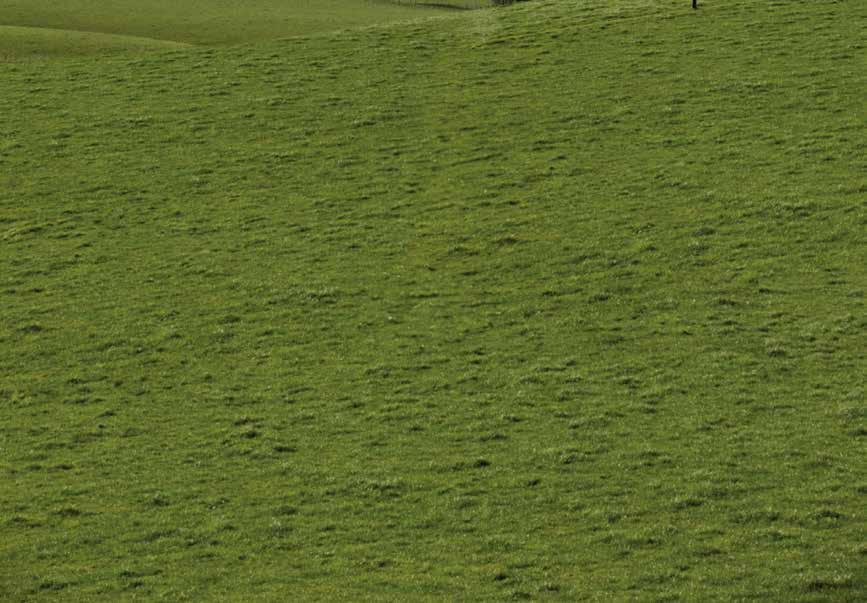


PERFECT PARTNER PASTURE’S
FAMILY-OWNED TARANAKI BUSINESS, GREEN MEADOWS BEEF, WILL SUPPLY 5200 MEAT MEALS TO 'MEAT THE NEED' OVER THE NEXT 12 MONTHS, INCLUDING MEATBALLS, PATTIES AND SAUSAGES.
With this support, the farmerled charity can donate to two more foodbanks in the region, it says.
Green Meadows Beef cofounder Nick Carey says they are honoured and proud to be able to give back to their community since founding the family business in 2012.
"At our heart, we are a paddock to plate business.
“This meant choosing to partner with Meat the Need was a no-brainer. Being able to support foodbanks from the farm and through the value chain is excellent and an initiative we were eager to support.”
The company wants to support its local community and target contributions to those who need it most.
"In the current economic conditions, ensuring those who need some support have access to good quality protein to
fuel their families is important to us.
“We know partnering with Meat the Need means our donations go to families in need and as we're a family business, it makes sense to grow healthy families through donating our 100 per cent grass-fed protein.”
The Carey family founded the family business from their land south of Opunake where three generations have farmed for the past 120 years.
Aiming to take the grass-fed Angus beef they farmed and deliver it direct to families across New Zealand, today they have an award winning online and export business and butchery in New Plymouth.
Meet the Need general manager Zellara Holden is thrilled to have their support,
“We are incredibly grateful to the Carey family. Their commitment to give back to their
Nick Carey, Green Meadows Beef, with Meat the Need general manager Zellara Holden�

community and nourish those in need with their locally grown protein is truly remarkable.”
The partnership will ease pressure for the charity’s services locally.
“The demand for our services is currently unprecedented with more than 100 food banks and community organisations on our waiting list so this means we may be able to look to other organisations in Taranaki who need us.” she said.
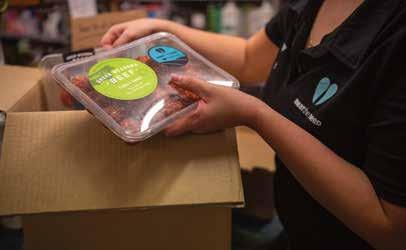




Our portfolio of powerful, proven products has helped growers from one end of New Zealand to the other create and maintain thriving businesses, and has earned us an excellent reputation in horticultural crop protection.
Our suite of insecticides and fungicides provide growers with everything they need in the war against pests and diseases. Visit corteva.co.nz to view our range of products and online horticultural resources.

this month we look at...
IF YOUR FARMERS HAVE EVER WONDERED WHAT THE FINANCIAL RESULT WOULD BE IF THEY LET PASTURE WEEDS GET AWAY ON THEM, THERE’S NOW A GREAT WAY TO SHOW THEM THE ANSWER.
It’s free; they can personalise it to their farm and paddocks, and it will help quantify exactly what they stand to gain or lose by making certain spending decisions about looking after homegrown pasture this season.
The new Grassmanship online app from Nufarm is designed to help New Zealand farmers get the best out of their pastures all year.
Available at the grassmanship. nz website, it comes packed with features, including several calculators so your farmers can compare and contrast the outcome of different weed control scenarios in terms of net return on investment per hectare.
“Farmers intuitively know old run out pastures don’t produce as much feed as newer, higher performing pastures, just like they know maintenance fertilis-

er supports higher annual feed production, and improved animal genetics benefit their business,” says Nufarm North Island sales manager Richard Bell.
“However, during tighter financial times, it’s understandable to look for ways to trim on-farm costs, with feed, labour, and/or weed management programmes being typical budget categories that come under scrutiny.
“That said, the relatively small investment from controlling weeds in pasture – particularly newly sown pasture – pays a return within six to 12 months in a range of situations.
“That’s why we’ve loaded the Grassmanship programme with separate dairy-specific calculators for both the North and South Island that cover common scenarios like spring weeds, new pasture and winter weeds.”
Clean, productive pastures, year-round, offer a double win, Bell says, because they give your farmers both higher dry matter yield, and better feed quality, than those which are infested with weeds.
That sets up on-going systemic benefits, not least being easier grazing management, happier animals and more milk in the vat. Bell says in addition to the calculators, grassmanship.nz also provides useful information to help farmers and their advisors get the optimal results from a pasture protection programme, includes a range of Nufarm’s resources that support best practice.
Much of the background data is built from commonly referred to industry statistics and regional pasture growth data generated by Beef+Lamb NZ and DairyNZ.



The tool assumes good agricultural practice – using the right products at the right rates and at the right time. Spraying weeds earlier, rather than later often yields the best results, he says. Grassmanship.nz is the first of a suite of decision support tools for farmers and rural professionals that Nufarm plans to develop further.
To find out more about the app, visit the grassmanship.nz website or scan the QR code.
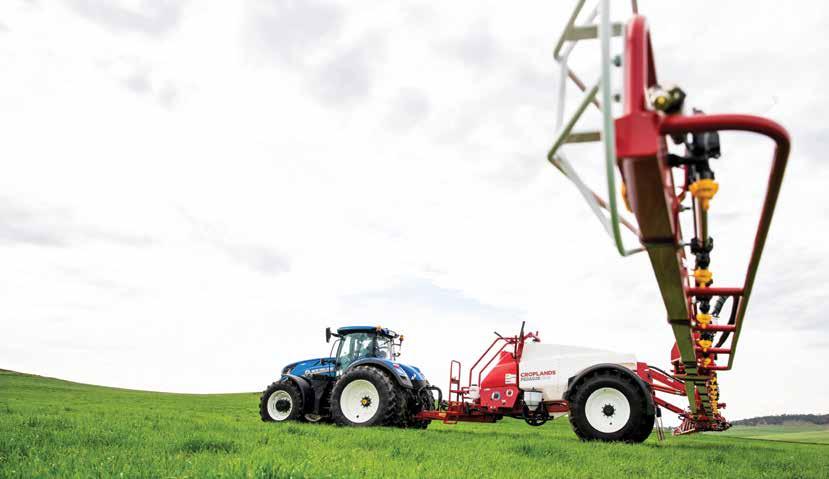
WORDS: PGG
Wrightson SeedsTHE UNIQUE PARENTAGE OF PALLISER TETRAPLOID LONG ROTATION RYEGRASS BENEFITS MULTIPLE LIVESTOCK FEED SYSTEMS DUE TO GROWTH THROUGHOUT THE YEAR, INCLUDING WARMER AND COOLER MONTHS.
Trial testing across New Zealand has proven Palliser offers something different.
Palliser has retained the traditional benefits of hybrid ryegrasses, but due to its late flowering, reduced aftermath heading (AMH), and rust resistance, Palliser offers additional summer quality benefits.
High-quality annual and seasonal dry matter yield enabled Palliser to stand out in the breeding programme.
Plant breeders put special attention on improving summer quality traits, including low AMH coupled with disease tolerance, notably crown and stem rust.
Before Palliser became commercialised, it was extensively tested in trials NZ-wide, in all kinds of conditions, from dryland East Coast to wet and cold
It has consistently shown its value with its early spring production and keeping its quality of leaf longer than earlier heading varieties.
The parentage combination of Palliser allows for cool season activity with quality growth in summer and autumn.
Palliser (+25 heading) combines Italian and perennial ryegrass genetics
It is ideally suited to pastures lasting for three to five years, or alternatively, it can be used to undersow existing pastures to extend longevity.
Trial testing has concluded that Palliser is suited to various farm systems where high-quality pasture is key.
These systems include dairy platforms, pasture silage, and sheep and beef breeding and


is its versatility within different farm systems.
Palliser achieves versatility because it can be adapted to a wide range of farm systems, which is determined by several factors, including:
• Crop rotation – can be used for 1-5 years.
• Environment – testing has shown versatility across NZ.
• Stock class – can be used for all classes (dependent on endophyte type).
• Late heading date – distributes spring feed flush longer.
• Grazing management – best suited for rotational grazing but can sustain periods of set stocking.
• Soil type – adaptable to most grazing soil types.
“We have been awaiting the
Wrightson Seeds national technical manager Wayne Nichol says.
“There has been an increased market trend for use of hybrid ryegrasses. This is likely a reflection of their versatility to be used for undersowing, specialised pastures or in association with perennial pasture mixes.”
Palliser retains the attributes of cool season activity, normally seen with hybrids but has additional summer quality benefits, he says.
“This is due to its very late flower habit, reduced AMH and very good rust resistance.
“Add AR37 endophyte and Palliser long rotation hybrid ryegrass together, and this only adds to the value proposition.”
For more information visit

proudly 100% New Zealand owned and operated family business based in Oamaru, North Otago Having over 30 years' experience in producing
Feeds is






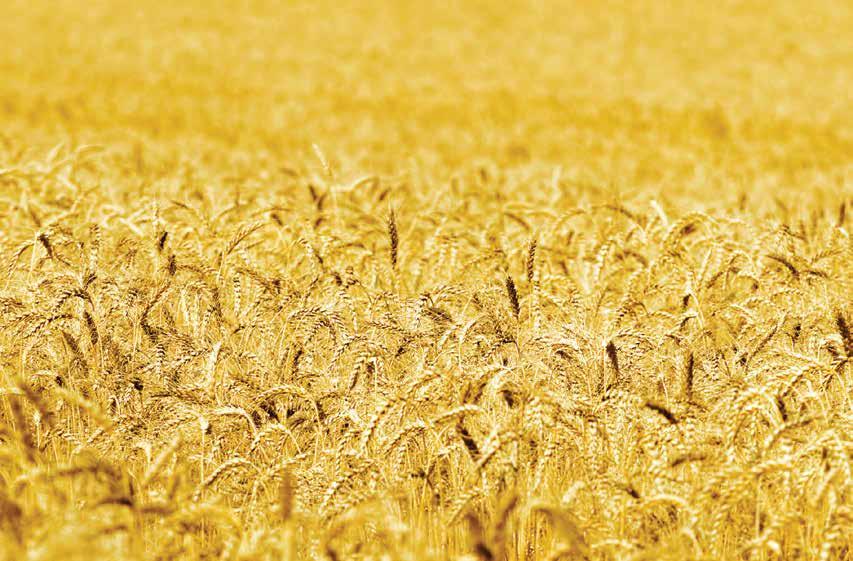
DON’T GET CAUGHT OUT
Make sure you are up-to-date!
• Over 140 new listings
• 160 deleted products
• 100 existing labels updated (new weed, pest & disease claims)
Plus the latest regulatory amendments
The definitive guide to agrichemicals registered for use in New Zealand.
A comprehensive alphabetical listing of products, active ingredients, crop & weed tables, weed & pest identification and much, much more all in one single publication. It really is the definitive agrichemical guide and the only one you’ll ever need.
Purchase a manual to receive a FREE 12-month subscription to our subscriber only website.
The website is continually updated and contains product listings, a fully searchable online product manual, a powerful search engine of weeds, diseases & pests, including photo galleries with all the agrichemical options to use on individual crops as well as up-to-date SDS’s, Haznotes and product labels, plus posts about industry news and information.
NOW to receive your FREE pair of SureShield Coveralls

SureShield Coveralls supplied by pH7, provides both protection and comfort with exceptional liquid and particulate protection. Ideal for a wide range of industrial applications. One size fits all.
Shigematsu Respirators supplied by pH7.
* Available to those who order directly from www.novachem.co.nz - while stocks last.
Print up-to-date SDS’s & Haznotes from novachem.co.nz to ensure you are compliant.
WITH BOBBY CALF NUMBERS INCREASING AS CALVING GETS UNDERWAY, IT’S A TIMELY REMINDER FOR VETS, RETAILERS AND FARMERS OF THE UPDATED MPI POLICIES REGARDING TREATMENT AND HANDLING OF BOBBY CALVES.
Tim Horsbrugh, intensives business manager for Zoetis, says retailers and vet practices who sell coccidiostats such as Bovatec 20CC®, or calf milk replacers (CMR) containing coccidiostats, should take the opportunity to remind farmers that these products are not for use in bobby calves.
Likewise, calf feeds containing coccidiostats should not be left in pens that house new bobby calves.
“Generally speaking, the label information is sufficient, however, some of the old habits need to change,” Horsbrugh explains.
“A gentle reminder about these policies to farmers when they purchase their CMR and calf
feed will not go amiss!”
As well as the regulations around feeding, loading and unloading, and shelter before and during transportation, farmers must ensure that calves are free from veterinary medicine residues as per MPI Operational Code NZCP1: Design and Operation of Farm Dairies (section 5.3 Bobby Calf Collection), issued in May 2017.
There is a zero tolerance for veterinary medicine residues in bobby calves, i.e. there must be no detectable residues at all, Horsbrugh says.
This is different to a ‘nil’ milk or ‘nil’ meat withholding period where drug residues may be detectable as long as they remain below the applicable maximum
WORDS: Milligans Feeds
AS WE ROLL INTO ANOTHER WINTER/SPRING PERIOD OF CALVING WE WANT TO QUICKLY REFLECT ON THE AMAZING AUTUMN WE LEAVE BEHIND.
For many, it was a fantastic calf rearing period compared to the previous year’s, which barely got going due to the very wet summer that dragged all the way into winter.
The much-improved weather this year has been great for calf rearing, and Milligans Feeds

No coccidiostats for bobby calves�
residue level (MRL) and are, therefore, considered safe for human consumption.
Bobby calves are classified as a separate stock class and specific residue testing for veterinary medicines must be performed on this class to obtain a nil bobby calf claim.
Unless the product explicitly states a bobby calf withholding period (such as Cydectin® Pour-On which has a nil bobby calf withholding period), then calves cannot be exposed to the product.
So, if a bobby calf has consumed milk from a cow that was treated with an antibiotic with a nil milk withhold, or has consumed milk replacer or feed containing a coccidiostat, it cannot be sent for slaughter since drug residues may be detected, thus not complying with the ‘zero tolerance’ rules.
For more information regarding bobby calf regulations, refer to the mpi.govt.nz website.
For more detail on Zoetis products, talk to your local Zoetis area manager.
has been out there early helping farmers maximise profits with our full range of products and competitive pricing, giving rearers more positivity moving forward into the harder months.
Apart from the great weather, another bonus for rearers was that milk replacer prices re-
mained flat from last year which made it a definite advantage to rear calves prior to spring.
Milligans also saw an increase in CMR use by winter milk dairy farmers who were looking to maximise whole milk gains in the vat by using a CMR as either a milk fortifier or stand-alone finisher – it’s so encouraging to see this practice being looked at more when applicable.
Now that we have arrived at spring, we know that the milk solids payout has remained buoyant, if not forecasted to lift, which is an encouraging sign.
While we appreciate for many, any extra dollars will be used to pay down debt, here at Milligans Feeds we believe we can assist in helping your farmers save money by choosing a CMR option from our range that can maximise milk
in the vat.
For those farmers who have been doing this for a few years, they will know the benefits of using a CMR not only for the direct money savings per litre, but for how consistent the milk replacer makes the milk, either fortified or on its own, leading to further possible benefits of faster growth with less health issues along the way, which can be an advantage for extra savings long term.
For the beef rearers, our traditional ‘bread and butter’ CMR users, we’ve got you covered with the same, high quality, proven performing products spanning 30 years.
Any one of our four CMRs will be suitable to feed calves at any stage, feeding system or cost, and we know our products perform at the highest level in con-
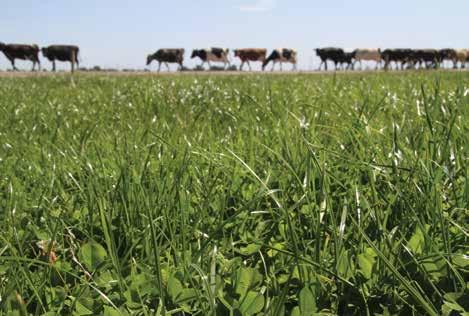
WORDS: Barenbrug
IF THERE WAS EVER A SPRING FOR DIGGING INTO THE TRUE VALUE OF DIFFERENT TYPES OF PASTURE SEED, THIS IS IT.
Cost pressures are severe for many red meat farmers, especially those who have had months of minimal grass growth and high supplement bills because of dry weather.
But your dairy customers aren’t immune from budgetary restraints either, although their market outlook is brighter.
Pastures will need to be sown (or re-sown) this spring, so what’s the best way to make sure farmers get the best possible outcome, not just immediately, but in the medium term as well?
The first step is to recognise that a short-term fix, for whatever reason, will still need to be resolved sooner rather than later, with all the associated expense of following up – more
junction with a strong rearing system. Having a high-quality milk replacer, which drives good growth weights and a seamless transition to hard feed for better rumen development, is key to create happy and healthy, well-growing calves – this is the main driver for Milligans Feeds when formulating our milk replacers.
We understand the challenges and uncertainties that farmers are currently facing, and we are committed to providing them with the support and guidance they need to succeed.
If you know new, current, or past users looking at options this year for their calf rearing milk replacers, contact Milligans Feeds on 0800 STOCKFEED or check out our website at milligansfeeds.co.nz - we would love to talk to you!
seed, more tractor or contractor time.
Annual ryegrass sown this past autumn as a cost-saving measure, for example, was only an interim solution.
After six or eight months, when it runs out, those pastures will start going backwards again without further renewal, which in turn means spending more money.
The second step is to acknowledge that uncertified seed, while cheap, is unlikely to deliver value for red meat or dairy customers. In fact, it might do the opposite. There is no knowing what it contains, or how it will perform.
Of all the potential fixes available to farmers this spring, uncertified seed is the riskiest, for
Pasture eaten remains a key driver of profit on farms�
many reasons.
It can introduce new and unwanted weeds, produce low yield or bring other issues associated with seed of unknown origin and quality.
At the other end of the spectrum, with least risk and highest lasting value, is certified seed of top proprietary perennial ryegrass like Array and Maxsyn. There is no question their yield, quality, seasonal growth and performance will give the best return on every dollar spent on pasture renewal this spring.
Quality, germination, purity and endophyte are guaranteed and the long term value inherent in these advanced genetics has been demonstrated time and again.
We realise some farmers can’t afford to sow as many paddocks in these high-value perennials as they’d like this spring.
For them, value might best be achieved with a hybrid like Shogun or Forge.
These will grow 1.5 tonnes more dry matter per ha through the cool season than a perennial for two to five years, with higher palatability for improved animal performance. They’re not perennials and they will need to be replaced, but in the medium term, they’ll help your farmers get through the next few years with reliable, quality, cost-effective feed.
Pasture eaten remains a key driver of profit on farms, and when times are tight pasture is critical to drive production and dilute farmers’ costs per kilogram of milksolids or meat produced.
Even if it means renewing only one paddock really well, with proven pasture genetics, your customers will be better off in terms of value doing this than sowing multiple paddocks with uncertified seed this spring.
If you’d like to talk this through in more detail, contact your local Barenbrug area manager today. We’re here to help.

RAGT
IN NEW ZEALAND’S DYNAMIC FARMING LANDSCAPE, STAYING AHEAD MEANS EMBRACING INNOVATIVE SOLUTIONS, ESPECIALLY WHEN IT COMES TO PERENNIAL RYEGRASS.
After many years of development, RAGT is proud to introduce its own novel endophyte, RGT18.
RGT18 sets the bar high by offering superior tolerance against a wide array of insects, surpassing the renowned AR1.
It ensures peak animal performance, while minimising the risk of staggers.
Rigorous testing, including extensive agronomic trials and assessments for insect protection and animal safety, underscores the exceptional performance of RGT18.
Independent animal safety trials conducted over a comprehensive five-year period across diverse ryegrass genetic backgrounds confirm that RGT18 is a very safe endophyte for sheep, beef and dairy.
The benefits of RGT18 are impressive.
With its strong tolerance to key pests like black beetle and Argentine stem weevil, RGT18 offers NZ farmers a comprehensive solution to mitigate insect pressures and increase persistency. Ongoing trials for pests like porina promise even broader protection.
RGT18 is now available with RAGT Hustle, a variety that stands out as one of NZ’s top-performing perennial ryegrasses.
Now fortified with RGT18, Hustle emerges as a powerhouse, offering incredible pest protection precisely where it's needed most.
PBRA trials further validate the exceptional performance of Hustle RGT18, cementing its status as a standout choice for farmers seeking premium quality and reliability.
For more information visit ragt.nz.


...driving real engagement, achieving real results.
We are a marketing, digital and media agency that offers clients all three areas of expertise under one roof. At Hot Mustard, we use a broad range of tools, experience and savvy to help you identify your audience and get them to pay attention. We do this by developing a deep understanding of your business, your customers and your goals and then creating a unique strategy to drive engagement and measurable results.
Free planning workshop.
We know it’s been a tough year for a lot of businesses, so we’re offering a FREE* two-hour planning workshop for a limited time to give you some fresh ideas.
Get in touch with Natalie today. natalie@hotmustard.co.nz 021 031 4869
THERE’S ONLY ONE THING WORSE FOR YOUR CUSTOMERS THIS WINTER THAN LOTS OF BRUSHWEEDS INFESTING WHAT WOULD OTHERWISE BE PRODUCTIVE GRAZING LAND, AND THAT’S KNOWING IF THOSE WEEDS ARE LEFT UNCONTROLLED, THEY’LL BE EVEN WORSE NEXT SEASON.
Ian Kirkland has been working with farmers and retailers long enough to have seen this scenario play out more times than he cares to count.


“What inevitably happens is that farmers get set back even further, and their productivity losses compound as brushweeds worsen.”
In other words, the effects of one tough season linger on to make it harder to get back on the right side of the ledger when markets improve.
But the long-standing Corteva Agriscience territory manager says there are ways to help clients move forwards with brushweed control even when budgets are tight and every expense is under scrutiny.
His advice for this winter?
“Help your farmers identify where they will get the very best return from money spent on brushweed control – the grazing land that will contribute most to
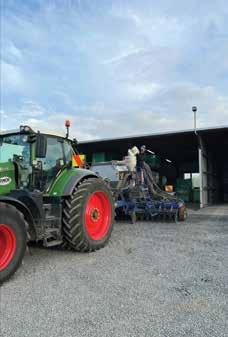
their productivity and efficiency when weeds like blackberry, gorse and broom are removed. It doesn’t have to be a big area.
“Then make a plan with them that will deliver lasting results.
If they control a smaller area of brushweeds very well, they’re going to be better off next season than if they don’t spray at all this winter, or worse, spray once then skip the follow up.
“After the first application of herbicide, a follow-up spray has to be factored into the plan. This will enable control of any regrowth in the first 18 months.”
The herbicide itself also makes a big difference, Kirkland says.
Tordon Brushkiller XT remains the best-known solution in this category for the same reasons its predecessor formulations were just as widely-used – it’s grass-friendly, reliable, effective
and highly efficient, particularly for aerial application.
Labelled for control of both common brushweeds like blackberry, broom and gorse, it’s also approved for spot and broadcast application on costly pasture weeds including ragwort and Californian thistles.
The combination of three active ingredients – aminopyralid, picloram and triclopyr – means farmers are effectively getting five litres of T-Max in every drum, Kirkland says.
“Aminopyralid makes a big difference to the reliability of control. The biggest challenge with aerial application is getting good coverage in often difficult terrain, so you need a reliable product to get adequate control from a single application.”
For more detail talk to your local Corteva territory manager.
DARCY FINCH, WHO WITH HIS WIFE RACHAEL OPERATES BUSY FINCH CONTRACTING BASED JUST OUT OF TE AWAMUTU, IS A HIGHLY RESPECTED CONTRACTOR WHO FRONT-FOOTS CHALLENGES.
Finch Contracting employs up to 40 staff at peak season and provides a complete service for farmers in the Waikato, spanning everything from cultivating, drilling and fertilising to harvesting, baling and cartage.
And the Finch Contracting team is not about to let slugs get in the way of providing great results for its clients, especially when it comes to the extensive, high value, maize crops which are an integral part of the region’s landscape, and rural economy.
Pieter Van Der Westhuizen, UPL NZ regional manager upper North Island, says Darcy was one of the very first in the area to recognise the advantages of using BioGro certified Ironmax Pro for slug control.
“Darcy saw an ad for Ironmax Pro and rang his rep. They assured him that it did a good job and was nontoxic.”
Finch says being nontoxic is a ‘nice-to-have’.
“And, if you’re getting the same performance, it’s a win/win for everyone. We’ve
HONEST WOLF HAS LAUNCHED A NEW LIMITED EDITION, LICENSED NEW ZEALAND TEAM RANGE OF QUALITY WOOL AND LEATHER ACCESSORIES IN THE BUILD UP TO THE PARIS 2024 OLYMPIC GAMES.
Sam and Sophie Hurley, founders of the fast-growing luggage and accessory brand, both come from competitive rowing backgrounds and say the new designs are their way of supporting the team.
Highlights of the range include a wool cap featuring the NZ team embossed leather patch, a weekender bag which has a message of encouragement ‘we are the NZ team’ embossed on its luggage strap, and a passport holder made with homegrown Papanui Estate Wool.
All are perfect travel additions for anyone heading over to France to see the action live, they say.
Sophie Hurley, supreme award winner at the Rural Women NZ Business Awards late last year, represented NZ in world rowing at a younger age, and creating a special Honest Wolf range for the athletes has helped fulfil part of a long-held dream.
“As a rower through school and
Uni, my goal was to head to the Olympic Games.
While I may not be there this year, this new range is a way to represent the NZ team in another way,” she says.
Images showcasing the range feature two local Olympic athletes, rower Lucy Spoors and cyclist Sam Dakin in their element.
Spoors is a silver medal winner at the previous Olympic Games and had previously rowed aside Sophie Hurley.
Dakin is also heading over to France to compete in his second Olympic Games.
NZ Olympic Committee commercial director Sharon van Gulik is thrilled about the range and says the organisation was drawn to Honest Wolf for its quality craftsmanship and being uniquely NZ.
“For any brand aligning with the New Zealand Team, it is essential they reflect the values of Aotearoa New Zealand.
“Kiwis are renowned for their


ingenuity and community spirit, qualities that Honest Wolf embodies through its support of regional farmers and its line of functional accessories.
“Honest Wolf is celebrated for championing one of the country's finest natural resources— wool.
“The versatility and durability of each design make them perfect for a NZ team travel collection.”
The Hurleys, who farm sheep and beef on 3300 ha at Taihape, launched Honest Wolf in June 2020 as an online store selling ethical luggage and bags made from wool.
They have since opened a flagship store in Hunterville, and now employ six full and part time employees.
For more information visit honestwolf.co.nz.
had no issues with Ironmax Pro performance, and it flows well, which is important for our metering systems.”
Finch Contracting has used Ironmax Pro for crops ranging from chicory and turnips to grass and maize.
Finch believes with slug control there’s no room for complacency.
In his experience, slug pressure can vary a lot even from one paddock to another on a single property.
“Slugs are something you just need to assume are there.”
With increasing amounts of land either strip till or direct drilled, the reliance on cultivation for
slug control is becoming even less relevant.
Van Der Westhuizen says BioGro certification doesn’t mean Ironmax Pro is a less effective product.
“On the contrary, it’s equally as efficacious as market leader and sister product Metarex Inov.”
He says progressive contractors like Finch Contracting have a strong focus on best practice and doing the best by their clients, their staff, and the environment.
“They appreciate the Ironmax Pro BioGro certification, but they’re not going to sacrifice performance, or their professional
reputations – ever.
“Yes, Ironmax Pro is safer for beneficial insects, farm dogs and other domestic pets but, when it comes to slugs, it packs a real punch.”
Ironmax Pro is rainfast and contains the optimized active ingredient 24.2 g/kg ferric phosphate anhydrous, referred to as IPMax.
Iron (ferric) phosphate is a natural component of soil.
In Ironmax Pro, it works as a stomach poison on slugs and is fatal once ingested.
“Slugs get a gut’s full and die.”
Moreover, Ironmax Pro uses Colzactive technology developed from oil seed rape mol-
ecules selected for palatability, feeding preference, and rapid detection by slugs.
Van Der Westhuizen says the risk slugs pose, especially for vulnerable seedlings, including newly established permanent pasture, mean yields can take a hit if the population gets out of hand.
“The fact that slugs can consume more than 50 per cent of their own body weight in a night’s feeding and produce 300 eggs in their 13-month lifespan, is the stuff of farmers’ and contractors' nightmares.”
For more detail contact Pieter Van Der Westhuizen at UPL NZ.
OUTDOOR CLOTHING BRAND STONEY CREEK HAS ADDED ITS WEIGHT TO THE NASCENT WOOL REVIVAL WITH THE LAUNCH OF A BIG NEW RANGE OF 100 PER CENT NEW ZEALAND WOOL GARMENTS FOR MEN, WOMEN AND CHILDREN.
Strong Wool, Nature Wool and Opti Wool are the company’s answer to those who have asked what it can do to support rural NZ, and follow years of discussion, planning and design.
After rolling out the new range at Mystery Creek last month, Stoney Creek says it wants to take the clothing wider through its wide wholesale and retail partner network, and hopes other NZ companies with a stake in the rural community, along with businesses and consumers, will back the initiative.
“The reasons for our new 100 per cent NZ Wool Range are simple,” says CEO Brent McConnell.
“We want to pay the farmer more for their quality produce. We want to fine tune our manufacturing and supply chain to offer more value.
“We want to deliver a quality product to the consumer at a good price. And we want to influence the industry and other wool manufacturers to achieve a better result for the farmer.”
Aiming to deliver a range of quality wool products that the company could be proud of, and one that would help put some pride back into wool, Stoney Creek spent months talking with farmers, growers, wool industry experts, supply chains, and local and offshore manufacturers.

It also researched both competitors and consumers.
“We have fully immersed ourselves within the wool industry, looking at how we get it from hoof to human; how we make it economic, so we can offer more value than what the farmer currently has; and how we take it through a supply chain to produce technically very-very good products.”
McConnell says what the company discovered during this process was that the terms ‘NZ made’ and ‘made from wool’ in general were used loosely by a number of manufacturers and there were quite a few misconceptions in the industry.
So it’s focussed on transparency and showing customers where it has sourced wool used in the garments.

This year’s range includes clothing across three separate wool categories, each with their own characteristics balancing durability, softness, comfort and performance for both on- and off-farm wear.
Stoney Creek marketing director Brendan Li says it’s the start of an important journey for the company.
“For those who are Stoney Creek brand proud, or those who are staunch NZ wool and rural industry supporters, we trust this new range will provide some clothing options that’ll satisfy their demand, and help contribute towards further supporting NZ farmers and helping to rejuvenate our NZ wool industry.”
For more information visit stoneycreek.co.nz.
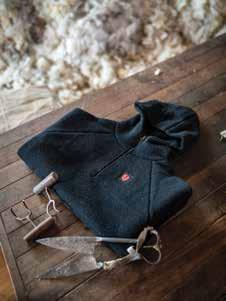
NEWS TRAVELS FAST IN RURAL NEW ZEALAND, BUT EVEN SO, FARMLANDS SAY IT WASN’T EXPECTING TALK OF ITS NEW DIGITAL TOOL TO SPREAD AS FAST AS IT HAS.
FarmlandsPRO is a bespoke online and app based tool that allows customers to place, track and manage their rural supplies orders themselves.
Several hundred farmers and growers who have started using the pre-launch version are already benefiting from gaining greater control of their essential rural supplies, the co-op says.
“We know that farming doesn’t line up with normal business hours – and our customers need to be able to order rural supplies at a time that meets their business needs, not ours,” says CEO Tanya Houghton.
FarmlandsPRO includes everything from full order histories,
through to existing contracts and farmer-specific discounted rural supplies prices.
It reflects how farmers and growers are adapting the ways they do business and how Farmlands is continuing to evolve to better meet customer expectations
“We’re acutely aware of the challenges the rural sector is facing and the need for us to be more responsive and available,” Houghton says.
The co-op plans to add future functionality to FarmlandsPRO that will help customers take even more control of the products they need and lower input costs.

These features will include providing seasonal recommendations and offers based on sales history to help Farmlands source core products at scale and provide a better customer price. FarmlandsPRO will also allow Farmlands technical experts to spend more time supporting their customers in solving onfarm or orchard challenges, and less time processing orders.
Feedback from customers using the pilot version has been very positive.
“We’re already starting to hear that neighbours are talking to one other about FarmlandsPRO – how it speeds up placing orders and getting supplies on to farm, which lets them get back to what’s most important. That’s

exactly what we hoped for with this tool,” Houghton says.
WHEN CYCLONE GABRIELLE HIT IN FEBRUARY LAST YEAR, IT LEFT AN ESTIMATED $13.5 BILLION WORTH OF DAMAGE AS ONE OF THE COSTLIEST TROPICAL STORMS NEW ZEALAND HAS EXPERIENCED.
Soon after, Commence the Re-Fence was born, with machinery dealership Stevenson & Taylor and CNH working with Federated Farmers to start helping farmers in Hawke’s Bay and Gisborne reinstate kilometres of lost fencing.
Stevenson & Taylor, in conjunction with CNH, donated two tractors - a Case IH JX100 and a New Holland TD5.90 – to the refencing effort.
Once Commence the Re-Fence came to an end, the intention was to donate the two tractors to farmers seen as in need of some additional support, and now two recipients have been announced.
Lil Poulton has put the Case IH tractor to work on her property at Patoka, while Colin Skudder, from Tokomaru Bay, has taken home the New Holland one, both farmers overwhelmed by the gesture.
They were selected from ‘dozens’ of nominations in a task
Lil Poulton and her children run sheep and beef on 440 ha in western Hawke’s Bay.
They lost a lot of fences and two bridges in the cyclone, with tracks and culverts also severely impacted by erosion.
They’re almost back to pre-cyclone production, but it’s been a tough road made even tougher by the loss of her husband Rob only a few months after Gabrielle.
“It’s just so incredible to have been given this tractor; we’re so grateful and very humbled. The level of support we’ve received has been amazing, and to me it shows our rural communities are just the best of people,” Poulton says.
Colin Skudder manages Marotiri Farm Partnership in Tokomaru Bay, and while the property was badly affected by the cyclone, it was his efforts as Civil Defence Lead for the community that secured him the New Holland TD5.90.

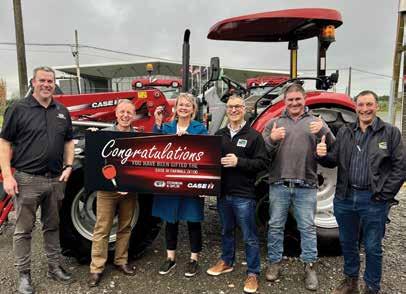

He says many others were worthy of nomination and he was humbled to be selected.
“We all worked so hard over the five weeks we were locked in Tokomaru Bay,” he said.
The community was isolated after the cyclone, and Skudder was instrumental in clearing a track that enabled daily trans-
port of hospital staff, medical supplies, nurses and doctors, food and water as well as required tradesmen, electricians and builders to Te Puia Springs.
GALLAGHER AND BARENBRUG FORMED A NEW JOINT VENTURE TO ACQUIRE ASSETS OF FARMOTE SYSTEMS, AN AUTOMATED PASTURE MONITORING COMPANY BASED IN CHRISTCHURCH WHICH WENT INTO RECEIVERSHIP IN JANUARY 2024.
Farmote Technologies is 70 per cent owned by Gallagher with Barenbrug holding the remaining 30 per cent of shares.
This strategic partnership underscores both companies' commitment to advancing agricultural technology and providing innovative solutions to farmers worldwide, they say.
Farmote Technologies' cutting-edge pasture
monitoring system will be integrated into the extensive product and service offerings of both Gallagher and Barenbrug.
While the new company set-up is in its early stages, the joint venture is dedicated to ensuring a smooth transition for existing Farmote Systems customers.
"We are excited at the prospect of further
FIFTY YEARS AFTER ITS HUMBLE BEGINNINGS, A WELLINGTON-BASED COMPANY IS THIS YEAR CELEBRATING ITS CONTINUED SUCCESS AS A LOCAL AG EQUIPMENT MANUFACTURING POWERHOUSE, WITH GLOBAL DISTRIBUTION CENTRES IN THE UNITED KINGDOM, UNITED STATES, AND AUSTRALIA.
In 1974 Maurice Wooster acquired what was a one-person business specialising in abattoir and other meat works equipment.
The company rapidly evolved, driven by a passion for innovation and a commitment to serving the needs of farmers across NZ.
This growth led to establishment of leading brands Runrite Abattoir Equipment, Cutrite Harvester Blades, and Strainrite Fencing Systems.
For Wooster, the biggest priority was keeping manufacturing here in NZ to preserve local skills and expertise.
“It’s a skill we do not want to lose because once it’s gone it’s gone.”
Many companies outsource manufacturing overseas to keep costs down.
“We concentrate on the mechanisation to help reduce costs to remain competitive.”
Even so, Strainrite still employs over 60 staff members across the three divisions, proudly maintaining its status as a 100 per cent NZ-owned and operated entity and the sole NZ manufacturer of permanent wire strainers.
Reflecting on the company's achievements, Wooster high-
lights the development of the Ratchet Handle as a proud moment
“One Saturday morning I went into the workshop, and two hours later I had it designed and manufactured. I wanted to reduce farmers' frustrations and break away from making brandonly gear.
“Our ratchet handle is a testament to that. It’s a simple product, yet compatible with all brands of wire strainers not just our own.”
“Another proud moment was seeing a Strainrite wire jenny for the first time at a NZ fencing competition. Only one team out of ten had our gear but it was a proud moment for me.” Today Strainrite is one of the most popular brands of tools and equipment seen at national fencing competitions.
"We receive considerable support from contractors and competitors when we transform their ideas into products they have confidence in and depend on,” Wooster says.
With a focus on product development and innovation, Strainrite prides itself on delivering market-leading fencing gear that withstands NZ's tough farming elements.
Case in point? The Activator

Strap, an International Innovations Award-winning new system for electric gate activators.
This unique post-termination insulator enables multiple gate handle connections, eliminates protruding activator plates, and saves time and money with single strap installation all while reducing potential harm to livestock.
Behind product development lies a team of dedicated engineers and designers committed to pushing the boundaries of fencing technology. Through rigorous testing and continuous feedback, Strainrite strives to meet the ever-changing needs of its customers and deliver solutions that redefine industry standards. Wooster remains humble despite the brand's growth and success over the years, emphasising the company's commitment to serving the industry above all else.
“My policy is to service the in-
dustry; for me, it’s not about anything else.”
Strainrite stays ahead of the game with fast and forwardthinking.
In 2017 its sustainability efforts included early adoption of cardboard packaging and last year it invested in two new machines to further enhance the efficiency of pigtail production while maintaining a continuous recycling process for water throughout its plastic manufacturing.
As Wooster expresses his gratitude, it's evident that the success of Strainrite Fencing Systems is not just measured in milestones and achievements but in the enduring relationships forged with customers and stakeholders.
“We want to thank you for all your ongoing support over the last 50 years. We wouldn’t be where we are today without you.”
For more information visit strainrite.co.nz.

developing the Farmote technology through this new JV and integrating this solution into our precision farming offering," says Lisbeth Jacobs, CEO, Gallagher Animal Management.
“We first invested in Farmote Systems in 2022 and are proud to be working with Barenbrug to take this exciting technology to market.”
The latest move will strengthen Gallagher’s
product offering alongside products such as eShepherd virtual fencing, its new Auto Weigher, and satellite connected liquid monitoring solutions.
Barenbrug CEO John Thijssen says Farmote has been on the company’s radar since it was founded, demonstrating the performance of Barenbrug grasses in the field as well as supporting farmers to get the most from their pastures.
“The importance of data in modern agriculture cannot be overstated, as it enables precise decision-making and enhances productivity.
“By integrating Farmote's innovative services into our portfolio, we will not only harness valuable data insights but also offer new cutting-edge solutions to our customers.”
Biologicals are the next big growth area in plant health and crop protection

WHAT DO CUTTING-EDGE BIOTECHNOLOGY COMPANIES FROM SPAIN AND THE UNITED STATES HAVE IN COMMON WITH ONE OF NEW ZEALAND’S LEADING CROP PROTECTION SUPPLIERS?
Much more than you or your customers might initially expect, says Corteva Agriscience NZ marketing manager Glen Surgenor.
And that’s good news all round as the world turns increasingly towards biological plant health inputs for commercial, environmental and consumer reasons.
In fact, if all goes to plan, this year could see the first of a completely new type of Corteva product released here as a result of the company’s significant global investment in a very different type of chemistry.
It’s now been over 12 months since Corteva acquired two innovative developers of what’s shaping up as the next generation of inputs for farmers and growers.
Symborg, based in Spain, specialises in microbiological technologies, and Stoller, based in the US, is one of the largest independent biological companies in the world.
Glen Surgenor says now that they’ve both been integrated into Corteva globally, the local team is eyeing up promising opportunities for potential deployment of these new technologies in NZ.
“Globally, biologicals are the next big growth area in plant health and crop protection.
“They are forecast to increase in market value from about $9 billion today, to $30-
$35 billion by 2035, and our strategic direction as a company is to develop and launch solutions that support this transition.”
Several drivers are influencing this trend, he says.
“It’s becoming much more challenging to register and maintain registrations of traditional crop protection products both globally, and here in NZ. So it’s harder to bring new products to the market.
“And discovery of new molecules is slowing down. It’s still happening, but not nearly as fast as it was 20 years ago.
“Meantime on the market and consumer side of things, everyone’s looking for the softer touch, a more natural approach to producing the food they’re purchasing.”
Corteva is not new to natural products, he points out.
“We have over 20 years’ experience in research and discovery of these compounds, starting with Entrust Naturalyte, which is an organically certified, naturally derived insecticide.
“And of course Questar fungicide with Inatreq active is also derived from a natural compound.”
As a complement to synthetic crop chemistry, biological products are already being implemented into commercial food produc-
tion systems here and overseas, Surgenor says, with rising awareness and interest in this product category among NZ producers.
“It’s likely to be a slow burn in the initial stages. You can’t completely replace current products all at once.
“But the role played by biologicals in our existing crop protection and plant health programmes will increase over time. We see them as highly complementary.”
With an insider’s perspective, he’s excited about products and technology that Corteva has now folded into its global business as a result of acquiring Symborg and Stoller.
“There is some very cool stuff coming! It will probably be 18 months before we can roll out new technology from the Symborg and Stoller portfolios, but we are working hard to identify the best pathways into our market for these.”
Of particular interest is Symborg technology already deployed on farms overseas, which uses a natural bacterium to enhance plants’ nitrogen use efficiency.
Meantime, Corteva is progressing its plan to launch a different type of biological to the NZ market in the second half of this year, namely a product developed to mitigate the negative effects of stress on plant health.
OVER THREE YEARS OF EFFORT HAS SEEN DOZENS OF SMALL PAPER BAGS OF OAT SEEDS ARRIVE IN NEW ZEALAND FROM BOSNIA RECENTLY TO HELP PROTECT OAT GENETIC DIVERSITY FOR THE FUTURE.
It’s been a long collaboration between Adrian Russell from Plant Research (NZ); the James Hutton Institute in Scotland; NZ agricultural engineer and former aid worker Dr John Steven and Balkan researchers.
Russell says if they hadn’t acted, the collection would have been permanently lost and with it genetics that could bring new and improved oat cultivars.
One new local commercial variety has already been released in Bosnia and Serbia from this genetic base, he says.
“It’s an untapped resource that may contain important traits that will help to improve the competitiveness of NZ grown oats.
“For example, we may find new sources of disease resistance that reduce growers’ reliance on agrichemicals, or new traits that improve processing yield or quality for commercial products like porridge and oat milk.
“We also hope there will be new sources of early maturity as well as cold tolerance needed to mitigate climate change globally, because of their expected wide adaptation.
“We don’t yet know what’s there and what’s

not, but if it was lost, it would be lost forever, not only for NZ breeding programmes but also future breeding.”
Russell says the first priority is to grow out the advanced Balkan seed lines in NZ to bulk up the quantity of each one for safe longterm storage.
“We could only afford to bring in 10 grams of seed for each line, which is about 1000 seeds, so we need to refresh those straight away.”
Remaining seed is in safe storage in Scotland at the James Hutton Institute.
When funding ran out to pay for maintaining the oat germplasm collection at the Banja Luka Institute of Genetic Resources in Bosnia, researchers there contacted Dr John Stevens in NZ, kicking off what Russell says was a ‘huge process’ to get it out of the Balkans
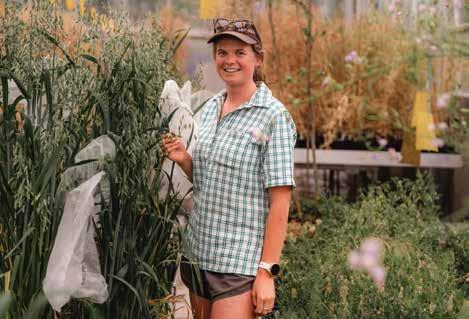
and save it.
Stevens had worked in the region during the Balkan war and earlier, helping set up and run an emergency seed programme, and subsequently became involved philanthropically in oat breeding there in the early 2020s, including oat genetics donated by Plant Research (NZ).
“The researchers at the Banja Luka Institute were very concerned their oat collection would be permanently lost – they’d already lost about 25 per cent - and the priority was to get it out of the Balkans,” Russell says.
“We couldn’t import it directly, because of our biosecurity regulations. The only way to get it here was to get it to a third party, in this case the James Hutton Institute, so they could grow it out, at their expense, and have it approved for NZ biosecurity clearance.”
Ultimately, he says, the goal is to get the Balkan oat lines into a more permanent collection in NZ like the Margo Forde Genebank, as well as backed up in Europe and the UK.
But for now, he’s happy that they have a more secure future than they did in Bosnia and that he can mentor their progress intergenerationally, taking over from Stevens after 36 years.
“As a plant breeder, genetic diversity is the life blood of a breeding programme and a successful programme always needs to look for new traits.
“Diversity can improve the competitiveness of new varieties and potentially provide new options for a changing climate.”
THE ENVIRONMENTAL PROTECTION AUTHORITY’S ANNOUNCEMENT THAT HI-CANE CAN CONTINUE TO BE USED IN KIWIFRUIT AFTER AN ARDUOUS REASSESSMENT PROCESS WILL BE MET WITH RELIEF BY GROWERS AND THEIR COMMUNITIES.
But it has come at a cost.
That’s according to New Zealand Kiwifruit Growers (NZKGI) CEO Colin Bond, who says the decision speaks volumes for the industry’s collaborative response through many years of hard work.
NZKGI led the industry to advocate strongly for the retention of Hi-Cane since the EPA’s call for information on the chemical in 2019.
A ban would have had a massive impact on many growers’ businesses and the communities that are reliant on the industry.
“The announcement of the retention of hydrogen cyanamide comes with some new controls, and we will now analyse the impact of these restrictions and consult with you on this in the near future,” Colin Bond told growers.
“Unfortunately, this reassessment has been a marathon, costing our small advocacy organization most of our retained earnings to fight.
“The doubt that has been cast on our industry over the last several years has had serious consequences on the well-being of our growers as well as creating financial uncertainty across the industry,” Bond says.
“Orchard prices have dropped significantly throughout the assessment, which will be partially attributable to the risk felt by investors.
“The reassessment would have no doubt inhibited growth at a time when export earnings are critical for our national economy.”
An independent economic report commissioned by NZKGI found that banning Hi-Cane in NZ would have a significant impact on the economy including Māori growers and their communities.
These concerns were voiced clearly by growers at the hearing on the reassessment, Bond says. The initial reason that the EPA

wanted a reassessment and proposed a phase out of hydrogen cyanamide was due to human health concerns.
Based on overseas information, the EPA was concerned that the chemical had carcinogenic properties.
However, evidence provided to, and accepted by, the EPA has shown that this is not the case.
“Despite these findings, the EPA continued with its reassessment and proposed a phase out of the chemical, albeit over a longer period than initially recommended, due to concerns that Hi-Cane is harmful to birds and some soil organisms.”
However, expert reports stated that the EPA’s risk assessments relating to birds and soil organisms were overly conservative and this is backed up by grower observations.
“The EPA's reassessment process has been arduous for us all,” Bond says.
Throughout the call for information on the reassessment, the EPA recognized that their models were out of date.
NZKGI will now begin conversations with the EPA around im-
proving their processes.
“Despite the decision, we will continue to protect our workers and environment and we are committed to an ongoing programme of continuous improvement and best practice that focuses on safe spraying practices both from a human and environmental health perspective,” Bond says.
The industry has adopted a coordinated approach to maintain safe spraying practice over many years, mandating low-drift technologies in relation to buffer zones and going above and beyond the required standards.
“In addition, we have engaged with the communities in which
we live and work, including an education programme, so that people who have remaining concerns can get a better understanding of the chemical.”
• The reassessment was triggered by a request to the EPA in February 2019 from John Levers, owner of Puketotara Lodge in Kerikeri. He claimed none of the controls for use of Hi-Cane was followed by local users; that it caused severe depression; was deadly to dogs, eels and ducks; and that Kerikeri’s reputation as the cancer capital of NZ was caused by the reckless spray practices of the kiwifruit industry.


Don’t let wet weather affect your spray out.
Stronger, faster and smarter – CRUCIAL® is the world’s first 600g/L triple salt formulation herbicide. It’s rainfast in only 15 minutes* with Pulse® Penetrant. For more information talk to your local Nufarm Territory Manager or visit nufarm.co.nz/crucial
SOUTHLAND DAIRY COWS MANAGED IN WINTER ON PASTURE WITH HAY BALES SPENT MORE TIME RUMINATING AND LYING IN POSTURES SUGGESTING GREATER COMFORT THAN THOSE ON KALE CROPS SUPPLEMENTED WITH BALEAGE, NEWLY PUBLISHED RESEARCH HAS FOUND.
Cows managed on pasture with hay also had higher skin temperatures and cleaner coats. The results suggest the greater opportunities for thermal comfort on pasture with hay may be due to both increased rumination activities and a more insulated lying area.
AgResearch senior scientist and lead author Dr Karin Schütz says the research was the first of its kind to show cows were warmer in a hay bale grazing system than forage crops.
Bale grazing is becoming more popular in New Zealand, but before this study, little was known about the welfare of cows being wintered in such a fashion compared with more traditional wintering practices.
AgResearch scientists joined with colleagues from Massey University in carrying out the study on Southland dairy farms with 80 Friesian cross-bred (Friesian and Jersey), nonlactating and pregnant cows, in the winter of 2022.
They investigated behavioural and physiological indicators of welfare of cows under two wintering practices: cows managed on a grazed kale crop with 5 kg baleage per cow per day; and cows managed on pasture with baled hay.
Their results have been published in the latest Journal of Dairy Science.
The research shows bale grazing systems can provide cows with several welfare benefits and help them conserve energy and
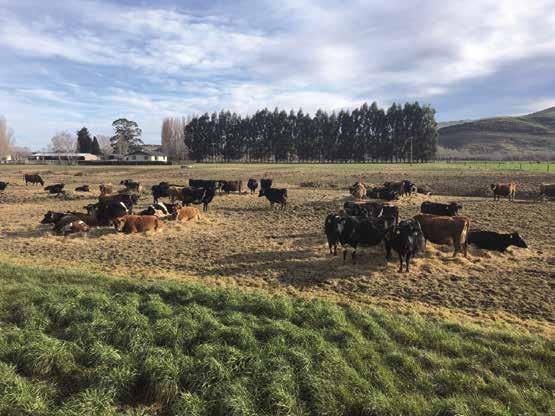
maintain normal body temperature, Schütz says.
“The diet of pasture and hay promotes rumination throughout the day and night which helps with thermoregulation when the weather is cold.
“The hay litter left from the hay bales gives the cows an insulated and soft surface to lie down and rest on, which we know cows prefer. This surface also helps with keeping the coat clean, which will also help with thermoregulation.”
The study lasted 35 days, during which time the cows’ lying and stepping behaviour was continuously monitored using leg-based accelerometers.
All cows were weighed and body condition scored before the start of the trial, and again on day 32.
Starting BCS was on average the same for both groups (4.5).
By day 32, kale crop cows averaged BCS 4.7, while those on bale grazing averaged 4.8.
Between day four and day 32, cows in both groups spent similar amounts of time lying, the scientists say.
Both groups reduced their lying on wet and cold days and there was evidence of rebound lying
once unfavourable weather conditions stopped.
Cows on kale took numerically more steps compared with cows managed on pasture with hay bales, the scientists say.
On average, cows on kale took 312 more steps daily per cow than cows on pasture.
“This is somewhat unexpected since cows on pasture had to walk more to obtain feed by grazing pasture and kale crop cows were only provided a small area of new crop on a daily basis.
“When we investigated the diurnal pattern of movement, we saw a peak in stepping in the late morning of the kale crop cows, coinciding with the provision of a new feed allocation. Due to the high nutrient content and yields of kale, limited new areas of feed are provided daily, which in turn causes competition between individuals.
“We therefore speculate that the high stepping rate in the morning is due to kale crop cows being more ‘frantic’ in their feeding behavior due to competition for the limited amounts and areas of fresh feed.”
All cows were blood sampled at day 0 and day 32 of the study to
Fully fed, content cows on bale grazing in Southland�
measure thyroxine (T4), nonesterified fatty acids (NEFA), white blood cells (WBC), and red blood cells (RBC).
Cows on kale had numerically higher NEFA and lower WBC compared with cows managed on pasture, although most physiological values were within normal ranges.
In a second phase of the study (days 34 and 35), cows were managed under controlled, replicated conditions in the two wintering practices using typical on-farm stocking rates (two or four cows per group in the pasture with hay and kale crop treatments).
During this period, cow behaviour, skin and surface temperatures, hygiene scores, feed intakes and ground conditions were measured, including use of an infrared thermal camera to obtain two images per cow per night.
When the cows were lying down, those on kale had colder noses than cows on the pasture with hay treatment, averaging 5.6°C less.
Before the cows went onto the smaller experimental plots, those that had been managed on kale had dirtier cows than those

on pasture with hay, and this level of dirtiness increased significantly during the two day observations, even though there was virtually no rain.
Dry, clean coats help cows withstand cold temperature, the scientists say.
Dry matter intake over the two days was higher for bale grazed cows than those on
kale and baleage; estimated ME intake was lower.
“Overall results suggest that cows in the pasture treatment were thermally more comfortable than cows on kale crops, despite these cows consuming more metabolized energy than pasture cows (31 MJ more per cow per day) and also despite conditions being dry.
“Other cow factors influence thermoregulation, such as the body condition of the animal. However, the cows in both treatment groups had similar BCS and liveweight and our results, therefore, suggest that it was the rumination process in combination with the more insulated lying surface that resulted in greater thermoregulatory comfort of the cows on pasture with hay.
“Research like this adds to the knowledge available to our farmers, vets, rural professionals and farmer groups as decisions are made about how best to manage stock through those challenging winter months,”
Schütz says
“As we deal with the environmental challenges around winter grazing, it is important we keep animal health and welfare considerations top of mind as well.”
Research into these different wintering systems has also demonstrated environmental benefits, in addition to those for the animals.
AgResearch senior scientist Ross Monaghan says environmental benefits observed in trials included greater opportunity to capture urinary nitrogen in the hay bale system, and therefore less nutrient loss, as well as less mud and soil damage.
The research into animal behaviour/welfare in different systems received funding from the Ministry for Primary Industries' Sustainable Land Management and Climate Change (SLMACC) fund, and AgResearch.

Words: Pioneer brand products
REFERRED TO AS 'DOWN COWS' BY DAIRY FARMERS, IS ONE OF THE MOST COMMON ANIMAL HEALTH CONDITIONS FARMERS FACE EACH SPRING.
Milk fever, or hypocalcaemia, is a metabolic disorder that generally affects dairy cows within 24 hours post calving but can occur two to three days post calving.
This condition results from low blood calcium levels, leading to muscle weakness, decreased milk production, and increased susceptibility to other diseases such as ketosis and metritis. In 2000, a New Zealand study indicated 33 per cent of cows had sub-clinical milk fever with an additional 7 per cent showing signs of clinical milk fever.
Cows suffering from clinical milk fever produced 14 per cent less milk, while cows with sub-clinical milk fever produced 7 per cent less milk.
In today’s terms, this disorder would cost the average NZ farm approximately $10,000 per 100 cows (at $8 per kg MS)1
Not only is it a costly condition, but an incredibly time-consuming and stressful one for your farmers at such a busy time of the year.
Like many animal health conditions, prevention is the preferred strategy to minimise the effects of milk fever.
Magnesium plays an important role in milk fever prevention.
It is required to produce hormones that aid absorption of calcium from the gut, and mobilisation of calcium from bones.
Supplementing with magnesium for two to three weeks pre-calving will reduce the risk of milk fever.
Magnesium sulphate and magnesium chlo-
ride are more effective than magnesium oxide (causmag).
Another effective strategy is adjusting the dietary cationanion difference or DCAD in the cow's diet.
DCAD refers to the balance of positively charged (cations) and negatively charged (anions) minerals in a cow's diet.
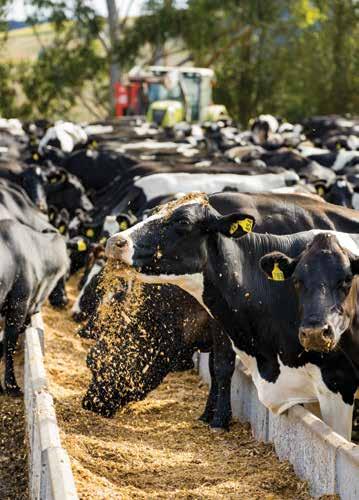
The main cations in the diet of a dairy cow are potassium (K) and sodium (Na), and the primary anions are chlorine (Cl) and sulphur (S).
This balance influences the cow's blood pH, which in turn affects calcium absorption and overall metabolic health.
A lower DCAD diet prior to calving can enhance calcium availability and reduce milk fever risk post calving (Figure 1).
The literature varies on how low the DCAD of a diet must be to make a difference.
Most nutritionists agree that a DCAD of less than 0 mEq per kg DM is ideal, however, if milk fever is a problem, getting below 200 mEq per kg DM will likely reduce your risk.
To achieve a low DCAD it is recommended to avoid feeding a diet high in potassium precalving, as it interferes with the absorption of magnesium in the rumen, and calcium absorption.
Often pasture, particularly in effluent paddocks, contains too much potassium for the transition cow.

Incorporating maize silage is a great way to reduce dietary potassium and milk fever risk post calving.
A reduction in DCAD can be achieved by reducing pasture intake and feeding low DCAD feeds such as maize silage combined with anionic salts during the transition period.
Some examples of anionic salts include magnesium sulphate, magnesium chloride, calcium sulphate or commercially available combinations of these products and other ingredients.
Another advantage of maize silage based diets is that they keep dietary calcium levels very low pre-calving (<0.5 per cent DMI).
This stimulates an increase in the proportion that is absorbed from the diet.
When lactation commences and the calcium requirements increase dramatically (up to 400 per cent), the cow can absorb a greater proportion of the calcium supplied.
Changing cows to a low DCAD diet should be done gradually, starting three to four weeks before calving to allow their metabolism to adjust.
By naturally lowering the DCAD and enhancing calcium absorption, maize silage can play a role in reducing milk fever.
For optimal results, dairy farmers should work with their vet, farm advisor or nutritionist to formulate a feed plan.
Testing of feeds ensures that the DCAD targets are met without compromising the supply of other nutrients during this critical period.
1DairyNZ.
2Lean, I., P. DeGaris, D. McNeil, and E. Block. 2006. Hypocalcemia in dairy cows: meta-analysis and dietary cation anion difference theory revisited. J. Dairy Sci. 89(2):669-684.
ANDY AND ANGE GOWER HAVE BEEN OPERATING PARAWERA FARM FOR 19 YEARS, WHERE THEY MILK 350 DAIRY COWS.
Their farming operation recently faced a significant setback due to unsafe conditions on their 2-yearold herringbone shed, where the concrete surface had become dangerously smooth.
The Gowers experienced two costly incidents where cows slipped on the ramp, resulting in significant financial losses and animal welfare concerns.
"When one cow slips over on the ramp, you just think, maybe she was just being silly. And then when it happens a day later with the second one, you know you're in trouble.
“Two cows at $1700 a cow, that's $3400.
“Both cows do an average of 400 kg solids at $8 per kg milksolids.
That's $9,800 gone just like that. That was the moment for both of us. We don't like seeing our girls like this.”
The Gowers chose NumatAGRI VGrip matting based on previous
positive experiences with the brand in their old shed.
They had explored various options at field days and say the decision was clear as other mats were too smooth and ineffective to meet their safety standards.
Installing the NumatAGRI mats was straightforward and efficient.
Initially, cows were hesitant due to the new surface texture, but within three days, they adjusted well, confidently navigating the ramp without any slips.
The mats were laid in just three hours between milking sessions, minimising disruption to the farm’s operations.
Introducing the VGrip mats has transformed farm safety and efficiency.
Cows now exhibit no hesitation when using the ramp, significantly reducing the risk of injuries.
The mats are easy to maintain, too; cleaning procedures remained as simple as with con-

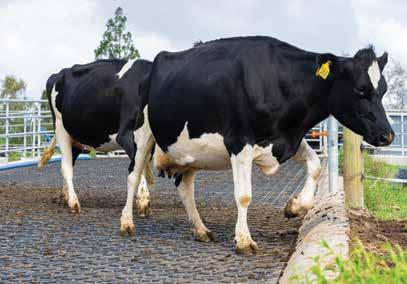
crete, with excellent drainage that allowed for quick and easy wash-downs.
The Gowers say the whole experience from initial consultation with the NumatAGRI sales team to installation has been very
positive.
“They just rock up, get the job done quickly, and the results speak for themselves. It’s been absolutely awesome.”
For more information visit numatagri.co.nz.
GEA AND AGRICULTURAL AI START-UP AGRIAI HAVE LAUNCHED A NEW WALKOVER TEAT SPRAYER TO HELP REDUCE MASTITIS AND DAIRY LABOUR REQUIREMENTS WHILE OPTIMISING COW WELFARE.
They describe it as a game-changer for boosting udder health.
Equipped with advanced AI-driven camera technology, it offers real-time udder tracking and timed sequential spraying, instead of break-beam sensors.
“This provides thorough coverage of both the front and back of the teats as the cow walks over the unit, regardless of her speed or how close the following cow is.
“These features set it apart from other products on the market, ensuring superior teat spray coverage as cows exit the cowshed.”
GEA and AgriAI say the sprayer includes advanced sensor technology that detects when nozzles need cleaning and automatically
sprays water to ensure they remain unobstructed.
In 2022, GEA introduced the iSPRAY4 onplatform teat sprayer for rotaries, featuring four nozzles and utilising crossfire spray action, rather than lateral spray, to cover both the teat barrel and teat end.
Recognising that 70 per cent of dairies in New Zealand are herringbone, GEA saw an opportunity to build on the success of the onplatform teat sprayer and develop a highly effective walkover teat sprayer suitable for both rotary and herringbone cowsheds.
Built entirely of stainless steel for durability and strength, the new design also features four nozzles and a crossfire spray like the on-
platform teat sprayer.
Development of the new sprayer is testament to the collaborative efforts of GEA’s New Zealand-based product, technology and innovation teams, and AgriAI co-founders Benedict Johnson and Chris Scherman, the companies say.
“It addresses the critical challenge of maximising milk quality and yield without compromising animal welfare.
“It reduces labour requirements during milking, ensures a consistent spray routine, and is easy to install and retrofit as a standalone unit.”
Unobtrusive design maximizes cow flow, and customers have access to remote GEA
LANDPOWER HAS OPENED THE DOORS TO ITS NEW STATEOF-THE-ART AGRICULTURAL RETAIL HUB IN CHRISTCHURCH
The new Yaldhurst building reflects the developing world of agricultural technology and comes as Landpower heads into their fiftieth year in business in 2025.
“It’s bringing the best of a family-owned New Zealand business and the latest agricultural machinery together in a world-class facility designed to help support our local customers”, says Landpower CEO, Richard Wilson.
The purpose-built facility has become home to three former sites across Canterbury – the Templeton retail store, parts distribution centre, and Landpower’s support office.
“This confirms our commitment
to a strong agricultural future in the Canterbury region, one that creates efficiencies and ultimately allows Landpower to deliver a better product, customer experience and service to local farmers and contractors.”
At a time where some businesses are conserving funds and making some tough decisions, Landpower owner Herby Whyte has kept his founding philosophy.
Whyte has consistently invested back into his company since his days farming in Southland.
This new building represents the next phase of his investment.
“I have always had a long-term view and this building is our base

support.
Mastitis is very costly for NZ dairying, causing hundreds of millions of dollars in losses annually.
According to DairyNZ, the average cost of mastitis for a herd of 300 mixed-age cows is approximately $54,500 per year, or $180 per cow.
Teat spraying after milking has been proven to reduce the incidence of new mastitis infections by 50 per cent.
However, manual teat spraying requires additional labour and risks inadequate coverage and inconsistent results if not done correctly. The walkover teat sprayer was launched at National Fieldays last month.

for the future, we will be bringing more staff into the region for training and career progression, and showing our commitment to Canterbury agriculture,” says Whyte.
Two additional features of the new building are the reserved area for equipment demonstrations, where farmers, contractors and growers can view and test out equipment first-hand; and the dedicated training facility on site, that will allow the company to deliver a higher standard of training to its technical team, Wilson says.
The site also features six retail service workshop bays, two advanced training bays, and a parts distribution centre that holds in excess of 30,000 part lines.
“With everything under one
roof, this creates a huge amount of synergy.”
To mark the occasion, Cathrina Claas-Mühlhäuser, chairperson of the CLAAS Group, joined Wilson and Whyte for the official opening ceremony.
This is her first visit to NZ and she spent time meeting customers and visiting farms throughout the South Island.
“We are delighted to have Cathrina here from Germany to mark this day with us. We have proudly represented CLAAS since 1987 and our long-term relationship has allowed us to provide the world’s leading machinery to our New Zealand customers,” Wilson says.
The new building was officially opened by Nicola Grigg, Associate Minister of Agriculture.
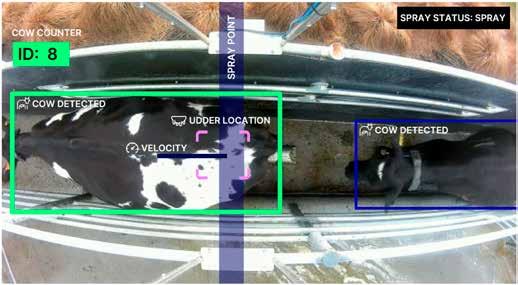
Real-time udder tracking means thorough teat coverage, regardless of cow speed�
SPEEDING UP THE APPROVAL PROCESS FOR NEW AGRICHEMICAL PRODUCTS TO IMPROVE TRADE AND ENVIRONMENTAL OUTCOMES PAVES A POSITIVE PATHWAY FOR FARMERS AND GROWERS NATIONWIDE, FOLLOWING A GOVERNMENT ANNOUNCEMENT IN JUNE TO WORK TOWARDS THIS GOAL.
This is welcome news for Animal and Plant Health New Zealand members, with positive implications for the entire country.
Our members, ranging from family-owned businesses to large multinational investors, are at the forefront of agricultural innovation.
Their work is crucial in tackling some of the agriculture’s greatest challenges—climate change, biosecurity threats, pest resistance, and the stringent requirements of export markets.
Today’s potential and tomorrow’s possibilities rely on innovation.
This was a consistent message shared at the recent Fieldays at Mystery Creek, as well as in the recently released KPMG Agribusiness Agenda - which explains that the global markets we sell our products to are setting expectations around how we operate.
We risk falling behind the rest of the world with no guardrails in place.
Innovative agricultural chemicals will enable our farmers and growers to protect their crops more effectively, adapt to changing conditions, and continue to prosper.
New products such as inhibitors are potential game-changers in the fight against climate change.
Combating biosecurity threats and resistance
NZ's biosecurity is constantly under threat from invasive species. It is vital that additional products are approved, such as those targeting fall armyworm.
We also have innovative solutions offering new modes of action to address any potential resistance issues that can result from relying on only one solution.
The backlog of pending approvals includes biologicals – sustainable pest management solutions derived from living organisms like natural predators, parasites, pathogens, or competitors. These residue-free alternatives leave a minimal environmental footprint
Accessing export markets
Our sustainability story is key to accessing export markets.
Markets overseas are increasingly fastidious about the products used to grow our food.
If we don't have options to reduce reliance on existing products, we will start losing access to these markets.
The role of regulation
Our regulators have an important role to play as gatekeepers of these innovations. The review offers an opportunity to look to the future and where we can streamline principles and approaches that considers the risks and the benefits of these innovations to NZ agriculture.
It must not be based on shortcuts.
Global competitiveness
Many innovative products available to our global competitors are still awaiting approval in NZ.
We hear of risks, but little about the many benefits these innovations can have for NZ when they are in the hands of our farmers and growers.
For instance, safer and more effective insecticides approved in the EU, USA, and Australia remain in the queue here.
Such delays can have significant repercussions.
If products are reassessed and removed without alternatives being approved, it could leave our farmers without necessary tools, adversely affecting productivity and sustainability.
One recent innovation adopted in NZ is an organically certified bioinsecticide designed to control mealybugs in grapevines. These pests overwinter on the roots and under loose bark, posing a significant threat as vectors for transmission of the economically damaging Grapevine leafroll-associated virus 3 (GLRaV-3).
It offers viticulturists a sustainable choice that can be used before and after flowering. Only one conventional insecticide is registered for the control of mealybug after the start of flowering.
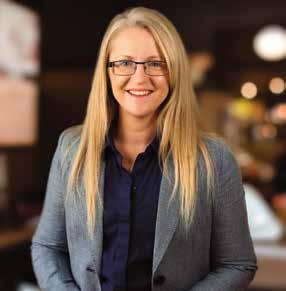
Late blight, a devastating disease affecting potatoes and outdoor tomato crops, has long been a major concern for NZ growers. A novel fungicide has a new mode of action and a lower application rate, with a lower environmental impact due to the ecotoxicity/ toxicity profile.
It also addresses the lack of options available to manage late blight and potential resistance issues.
The resulting lower residue levels in treated potatoes ensure continued market access for NZ growers.
These are a few of the recent innovations that have benefited NZ’s agriculture and economy in the recent years.
Animal and Plant Health NZ looks forward to working closely with the government and regulators to ensure these advancements continue to benefit all New Zealanders, while maintaining robust safeguards to protect human health and the environment in advancing complex regulatory changes.
• Animal and Plant Health NZ represents the New Zealand animal health and crop protection industries as well as rural retailers. The industry association promotes the benefits of safe, effective, quality products and services for the health of animals (including pet care) and crops. Its members are committed to the responsible use of products from research to disposal.
AS ANALYTICAL TESTING COMPANY
HILL LABS CELEBRATES ITS 40TH ANNIVERSARY THIS YEAR, MANAGING DIRECTOR JONNO HILL CREDITS ITS SUCCESS TODAY TO THE LEGACY OF THE STRONG CULTURAL VALUES THAT HIS PARENTS FOUNDED THE COMPANY UPON FOUR DECADES AGO.
Started in 1984 by Dr Roger and Anne Hill, Hill Labs has grown to become New Zealand’s largest privately owned analytical laboratory.
It uses the latest technologies to supply a broad range of laboratory tests to domestic and international markets in the agricultural, environmental and food industries.
Jonno Hill has spent his entire career working in the business, but neither he nor his parents really saw him coming to join it when he was younger.
“It was not until I was six months before finishing my PhD that I even considered it, to be honest. It seems crazy in hindsight because it's gone so well,” he reflects.
Taking on the managing director role in 2018, he says it’s been a wonderful exercise in experiencing intergenerational family business and the persistence of culture.
“Company culture and values accrue around the folks who are leading the business.
“Hill Labs was my parents' business, and so the culture and the values reflect the things

that they cared about. Of course, growing up I was also strongly influenced by those same values held by my folks, and so I think that's maybe why the company just feels like it fits so well.”
This sentiment is also shared by many employees.
Senior technician Gina McNamara has been with the company nearly 23 years and says during that time, she and her colleagues have formed a real community.
“There’s quite a few of us still here now that have been there since the beginning of my career. Together we’ve been through weddings, births, and all sorts of milestones that you would celebrate with your close friends and family. There’s certainly a sense that we’re working together for something special, and that’s one of the best parts about working for Hill Labs.”
Because Hill Labs’ culture and values are so deeply ingrained, it can be easy to overlook their significance.
Jonno Hill believes it’s important for leadership to be attentive and intentional in recognising and articulating these foundational elements and shaping the company’s ethos into words and actions.
“When we’re recruiting, particularly towards senior roles, we’re really explicit about our company values because it helps us attract

the kind of people whose personal values match with ours.”
A good fit for the business means having people join the team who are there for the long run and who know the value of taking a customer-centric approach.
Senior client service manager for key accounts, Graham Corban, has been with the team for 30 years and says there’s immense satisfaction in the company still being around and being stronger than ever.
“One thing that I really appreciate about Hill Labs’ leadership is that they have the courage to expand, grow and take risks, and as a business, we’ve deliberately chosen to focus on providing value to our clients,” he says.
Customer value is one of the key drivers that keep Hill Labs innovating now and will continue to do so in the future.
It all comes down to what people really care about, Jonno Hill says.
“We know it's turnaround time, quality, and customer service. And that leads us to think about how we manage our operations so that we can deliver those things.
“For us, operational excellence means having really good, streamlined processes, leveraging scale where we have it. And a really important ingredient for us - and one of the benefits of being privately owned - is that we invest heavily back into the business.”
Looking to the future, he is really energised by change and the myriad challenges that NZ and various markets are facing.
This gives way to huge opportunities for innovation in primary industries and environmental work.
Some innovations will be driven by technology; others will come from being clever in established areas by finding new ways to work with partners and customers.
“I’m looking forward to seeing how our business will change over time, and I'm open minded as to who we could be, and what we could be doing. That will be led by knowing what our customers need from us in the future, and where we believe we can be market leaders as our organisational capability continues to evolve.”
TODAY’S WORLD LOOKS VERY DIFFERENT TO THAT OF 1987, WHEN PAUL BELL AND NICKIE MILES FOUNDED HOT MUSTARD, THIS COUNTRY’S FIRST SPECIALIST RURAL MARKETING AGENCY.
New Zealand has undergone its own immense changes in that time, and few parts of the economy have experienced more ups and downs than our rural sector.
The pace of change is only increasing, not just for farmers but also in tech, marketing and media, and Hot Mustard is adapting its offering in response to the evolving needs of marketers.
A key component in this evolution is group account director Natalie Allen, who re-joined Hot Mustard last year after first working for the agency nearly 20 years ago.
Allen brings significant experience agencyside and in the retail sector, and she sees her lessons from retail as being crucial to what she is doing at Hot Mustard.
“Even though our current clients aren’t necessarily FMCG retail businesses, it’s still ultimately about understanding the customer, and using brand to drive conversion.
“I’m really enjoying applying those fundamental marketing skills to add value to our client’s businesses.”
Digital is another big theme of Allen’s CV, and she is using that know-how to help rural clients get better bang for their buck with their campaigns.
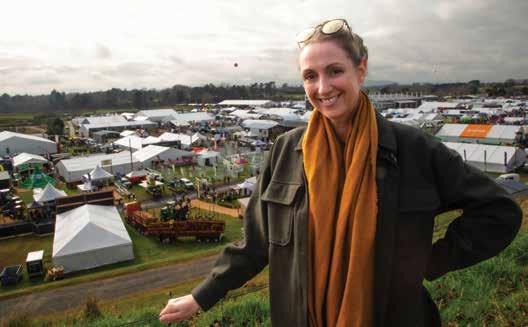
“We understand the pressures facing sales and marketing teams, and being able to add tangible value is exciting, especially at a time when every marketing dollar needs to be accountable.
“Hot Mustard has always been results orientated, but we’re taking it to the next level with investment in reporting tools that make it simple to see what’s working and what’s not.”
Hot Mustard is no stranger to adapting to new technology and forms of media; as Bell notes, they were the first rural marketing agency in NZ to use social media. Mobile phones, which were little more than
Top tips for spring agri-marketing
1. Recovering from this deep downturn will be a challenge for most agri businesses. The impact of restructures on product knowledge and continuity will be felt for a few years, so it’s going to be important to keep investing in building people and culture.
2. Keep up a marketing presence so that product is top of mind when the market turns. It is important to maintain your social presence, and continue to create engaging content that keeps conversations with customers going even when there is no appetite to purchase.
3. Be as efficient as possible with media selection, geo targeting where possible. Work out how you want to measure success and be prepared to change if the results don’t deliver.
a novelty when he started the agency back in 1997, are now a major source of media consumption for growers and farmers.
“Over 70 per cent of traffic to our clients’ websites comes from a mobile phone. It’s a big part of day-to-day farm business.”
With Allen on board, Hot Mustard can offer the best of both worlds: rural knowledge and cutting-edge marketing and digital expertise.
“We’ve got the experience both in sector and in marketing,” she says. “And we’re also just the right size, so our clients get to work directly with key people in our agency – making us efficient, agile and fully accountable.”
4. Be nimble enough to capitalise on any opportunities that may arise. The GFC and COVID-19 changed the marketing landscape considerably. Allen expects this downturn will drive agri-marketing further in a digital and social direction, but there will also be some big opportunities to stand out and make an impact in other print and broadcast-based mediums, as competitors potentially exit long-term partnerships.
5. Stay positive! While it feels more challenging than ever right now, things will improve, and new opportunities will arise. Be prepared to shift from maintenance to growth mode quickly when it does. Curious to learn more? Reach out to Natalie Allen at natalie@hotmustard.co.nz or 021 031 4869.
ity reporting requirements including climate-related disclosures; and
• emerging trade measures that relate to climate change and sustainability.
More than 80 per cent of NZ’s exports by value are now going to countries with mandatory climate-related disclosures (CRD)
either in force or proposed.
The report, Protecting NZ’s Competitive Advantage, by Chapman Tripp for The Aotearoa
Circle, is a point-in-time snapshot which focusses on two key trends:
• new climate and sustainabil-
An example of the latter is the EU’s Carbon Border Adjustment Mechanism, in force since late 2023, which now imposes a cost on embedded emissions in certain carbon-intensive exports to the EU.
Measures like this in various jurisdictions are anticipated to levy the carbon cost differential between domestically produced products and imports, depending on their carbon footprint and the equivalence of emissions regulation in their country of origin.
Chapman Tripp partner and report coauthor Nicola Swan says the extent of the changes and how fast they are happening may come as a surprise to some.
“The fact that more than 80 per cent of NZ’s exports by value are now going to countries with CRD either in force or proposed presents a challenge to exporters and their supply chains.
“NZ is heavily dependent on trade and offshore capital – we cannot afford to fall behind on increasing global demands for reporting on climate risk, GHG emissions and broader ESG capability.”
As well as trade measures and local regulations, those requirements may include clauses in free trade agreements (FTAs) which focus on climate and environmental standards.
The report provides material which enables government and business alike to both recognise key trends that are shifting the global operating environment for NZ companies and pin-point specific regulations that may affect them.
CEO of The Aotearoa Circle, Vicki Watson, says the scale of the changes documented in the report was a revelation.
“As an organisation built to focus on the restoration of natural capital, we are well aware that rapid change is happening in ESG reporting worldwide at both a government and major customer level.
“But seeing a snapshot of these all in one place is telling - over 60 per cent of world GDP is now subject to mandatory CRD measures, either proposed or already in force. This is a trend that is not going away.
“This report maps that trend, pulling together (for the first time) a summary of the raft of regulatory changes that are happening offshore. Having the disclosure requirements listed together with the latest trade regulations is key.

“We believe it’ll be an invaluable tool for New Zealand companies looking to future proof access to critical markets and international capital.”
Chapman Tripp was engaged to provide the report by The Aotearoa Circle, a partnership made up of around 50 NZ organisations from the public and private sectors working together to restore NZ’s natural capital.
ESG reporting is a rapidly evolving area in NZ and internationally.
Several jurisdictions already have or are considering mandating broader sustainability disclosures to include natural capital risk and some, such as the EU, already require this.
While the authors expect larger NZ companies may be directly affected by some of these regulations, many more will be affected indirectly via supply chain expectations and changing consumer preferences.
This will have wide-ranging repercussions for a range of businesses, from large corporates to SMEs.
“Think of a NZ exporter who supplies an overseas customer that is subject to mandatory CRD,” Chapman Tripp partner and
ESG reporting is rapidly evolving in New Zealand and internationally�
report co-author Alana Lampitt says.
“That customer is likely to look to its supply chain to provide information to support its disclosures and may in turn impose expectations on its NZ supplier to meet its own overseas regulatory obligations or voluntary targets. Failure to do so could put the business relationship at risk.”
Simon Tucker, director of global sustainability, stakeholder affairs and trade at Fonterra, welcomes the report.
“The number of Fonterra customers with science-based climate targets is growing. These customers are turning to suppliers to deliver their targets. Many other exporters will be in a similar position.
“This report starts a critical conversation about how NZ can take a strategic approach to navigating these changes in a way that protects export value and market access.” It will be critical for both the private and public sector to continue to monitor these developments to ensure NZ Inc has the information and tools needed to best position itself to respond in an age of transition and change.
The report is publicly available for free at theaotearoacircle.nz.


THE GOVERNMENT HAS CONCERNS ABOUT MIGRANT WORKER EXPLOITATION, AND ABOUT THE COUNTRY’S MIGRATION BLOW OUT. AND RIGHTLY SO.
How some migrant employees have been treated by scammers is nothing short of inhumane, and last year’s high net migration has added to housing and cost of living pressures (although, on the flip side, having a full workforce has also helped many employers).
Immigration policy is a lever the Government can control, and since the beginning of the year they have pulled hard.
In particular, there have been a number of regulatory consequences for the 30,000 or so accredited employers, consequences many may not know about, lost in the heavy haze of changes coming out of Immigration New Zealand (INZ).
Here are some of the latest key changes impacting employers in agriculture:
What’s new for Accredited Employer Work Visa (AEWV) applicants?
• Some in ANZSCO level 4 or 5 occupations will receive shorter visas and have a reduced maximum length of stay in New Zealand (from five years to a maximum of three years).
• ANZSCO level 4 or 5 occupations will need to meet the minimum standard of English.
• Most will need to meet a new minimum skill threshold and provide evidence of relevant qualifications or work experience.
What must AEWV employers now do?
• Take reasonable steps to ensure migrant workers are suitably qualified and meet the skills and experience thresholds before supporting an AEWV application
• Meet new advertising and hiring requirements for occupations at ANZSCO Level
4 or 5, including engaging with Work and Income.
• Continue to provide migrant employees on AEWVs with at least 30 hours of work per week, otherwise accreditation status can be revoked.
• Notify INZ within 10 working days if an AEWV holder’s employment ends if their last day of employment is more than a month before their visa expires.
• Plan ahead – accreditation, job check and AEWV applications processing times are going to blow out significantly
• Be prepared for post accreditation checks and inspections.
• Have robust compliance systems.
Minor mistakes, major consequences
On 6 January 2024 The Worker Protection (Migrant and Other Employees) Act came into force, aiming to deter employers from exploiting migrant employees.
These changes create a new infringement offence for lower-level immigration and employment breaches that can be quite minor or unintentional, with the migrant employee not being taken advantage of or negatively affected.
For example, working in a different location or role to the one specified in visa conditions.
Any violation of a person’s work visa could see employers fined up to $3000 per employee and even higher court-imposed fines.
If an employer is accredited, implications are even greater.
When immigration law and employment law collide
Employment law and immigration rules and

their application are often at odds with one another.
How wage thresholds are indexed in the immigration system to the median wage is an example where disparity can arise.
When the median wage is increased, the wage threshold for some work visas increases, and if a NZ citizen is paid less than an AEWV holder employed in the same role, there is an increased risk of claims of discrimination based on national origin or disparity of treatment under the Humans Rights Act 1993 or Employment Relations Act 2000.
The consequences of either immigration or employment non-compliance can be significant, with a simple mistake being potentially economically fatal for the businesses that are the lifeblood of our regions.
Hiring migrant workers is still beneficial
Hiring migrant workers is necessary for many in agriculture where workers are needed. They increase workplace diversity, share new knowledge, and fill important skill gaps.
The trick to making employing migrant workers go well is to have quality standards of governance and compliance risk oversight, and processes for managing risks related to immigration and employment.
When these things are right, then it is worth it.
NEW ZEALAND PRIMARY SECTOR INVESTMENT MANAGER MYFARM IS FORMING A NEW $190 MILLION KIWIFRUIT ORCHARD INVESTMENT VEHICLE AFTER INVESTORS IN ALL 11 OF ITS KIWIFRUIT ORCHARD PARTNERSHIPS VOTED TO AMALGAMATE.
The MyFarm KiwiFruit Fund brings together 13 Bay of Plenty and 4 Northland SunGold ki-
wifruit properties and the associated shares in the growerowned Zespri into what will be
one of NZ’s largest kiwifruit investment entities. The properties have just over
155 canopy hectares planted in SunGold and in the 2024 season produced more than two million trays of SunGold kiwifruit from a mix of developed and developing orchards.
MyFarm also plans to offer wholesale investors the opportunity to participate in the fund, with capital raising set to commence this month.
Farmers and beekeepers can work together for the coexistence of agriculture and bees.

Improve pollinator habits by planting flower boarders and maintaining hedgerows and unsprayed headlands.
Implement an integrated pest management plan to apply pesticides only when necessary.
Coordinate in advance with local beekeepers before spraying so nearby hives can be moved or otherwise protected.
Use genuine products only and alert authorities of counterfeit or illegal pesticides that have unknown impacts on wildlife.
Follow the instructions on the label to ensure you use the recommended dose. Avoid spraying in windy conditions to prevent spray drift.
Use drift-reduction application equipment that is well maintained and calibrated.
Avoid contamination from spray liquids when mixing, and properly dispose of waste and other used materials.
Avoid spraying pesticides when bees are foraging and plants are flowering.
Minimise dust from treated seed by carefully pouring it out of bags. Use seed planting machinery that eliminates the production of dust, and clean seed equipment regurally.
AGRICULTURE AND HORTICULTURE SOLUTIONS PROVIDER UPL
NZ LTD IS FAREWELLING COUNTRY MANAGER SCOTT HANSON AND WELCOMING ONBOARD BLAKE MACKIE , WHO WILL BE TAKING OVER THE HELM.
Hanson has left UPL to follow a new path, joining his family business in the marine industry.
During his time at UPL, he has initiated many changes, overseen significant milestones, and has also driven considerable growth for the business.
It’s been a journey he’s really relished and will miss.
“This has been a fantastic industry to be part of. Throughout my time I have enjoyed the people I have worked with, and the wide range of people I have met. The company is in a really good position, and I can see Blake taking it that step further.”
The UPL team would like to thank Scott Hanson, and acknowledge all his hard work throughout the years, his support, his knowhow, and the laughter, wishing him all the best for the future.
Entering the UPL business, but definitely no stranger to the industry, Blake Mackie has

a wealth of experience and knowledge, and significant agricultural credentials.
He was previously the general manager partnerships and growth at Plant & Food Research, managing the interface between science and partners.
Prior to that, Mackie spent 15 years with Syngenta Crop Protection, working in international marketing and commercial leadership roles based in Asia, Europe, and New Zealand.
Having taken on this new challenge, he says he’s excited by the potential of UPL’s OpenAg platform and their world-leading products.
“My background has provided me with a solid base in this area and I’m looking to build on that and working with everyone at UPL and our customers.
“Developing teams is a real passion of mine, and the role of country manager offers a great opportunity to enhance UPL’s already strong customer-facing commercial culture.”
BRAGATO RESEARCH INSTITUTE (BRI) IN MARLBOROUGH HAS APPOINTED DR JULIET ANSELL AS CEO, EFFECTIVE THIS MONTH.
“Juliet is a skilled science leader, bringing a wealth of experience to lead BRI in its next phase of accelerating research and innovation for the New Zealand wine industry,” says chair Mark Gilbert.
Ansell comes to BRI from her current role as head of core and resilience innovation at Zespri.
"I am excited to take on this new role and to bring my experience to grow the future of the wine industry,” she says
Ansell trained at Kings College London and has a PhD from Oxford University.
She lived and worked as a scientist in the United Kingdom, Tanzania, The Gambia, and Australia before taking up a role at Plant & Food Research in New Zealand.
In that role she led major research programmes with government and industry support involving lab-based research and human clinical trial work.
She was seconded to Zespri in 2014 as innovation leader,
initially working on human health and nutrition, delivering scientific substantiation of health communications and claims to marketing, before taking up her most recent role.
She has been an elected member of the Executive Council of AgriTechNZ representing Major Corporates. Ansell will relocate to Marlborough to lead BRI, and is looking forward to working with the wine industry, making new connections and meeting new people.


HE MAY NOT HAVE A FARMING BACKGROUND, BUT THE FIRST RECIPIENT OF THE NEW BARENBRUG PLANT SCIENCE INNOVATION UNDERGRADUATE SCHOLARSHIP IS DEFINITELY A FARMER AT HEART.
Angus Grant, who’s studying towards a Bachelor of Commerce (Agriculture and Professional Accounting), has already enjoyed a three-year stint on a research farm at PGG Wrightson, and began grazing lambs before he even finished high school.
According to Barenbrug marketing manager Jo Brady, his achievements make him a perfect fit for the organisation’s inaugural scholarship.
“Angus has really set the bar high, and we are looking forward to hosting him on a day out at the research station as part of his scholarship, so he can see how we operate,” she says. “It will be a great opportunity for him to get
a taste of how a global commercial agricultural company functions.”
Grant was first initiated into the farming lifestyle at the age of 10, when he had a conversation with a Southland farmer who owned the neighbouring house in his Papanui neighbourhood.
After that encounter, he began spending his school holidays at the Ohai sheep, beef and deer farm, as well as nurturing his entrepreneurial spirit.
“I’ve always been really keen on farming, ever since I was little,” he said. “As well as getting work experience on the Southland farm, I got into grazing empty, overgrown sections that had

been left vacant after the earthquakes. I traded lambs and ewes on around 20 blocks of land.”
He had his heart set on attending Lincoln from a young age, given the university’s agricultural credentials, and the fact that he takes his footy ‘pretty seriously’. Eventually, he hopes to farm full time.
Barenbrug and Lincoln enjoy many existing connections, with alumnus and Bledisloe Medallist, Selwyn Manning, founding Barenbrug NZ’s origin company, Agriseeds.
“Approximately a third of Barenbrug’s staff are Lincoln alumni
TAUPŌ BASED LOW CARBON DAIRY PROCESSOR, MIRAKA, HAS APPOINTED SENIOR MARKETING EXECUTIVE SARAH KEMBER AS ITS NEW GENERAL MANAGER OF SALES AND MARKETING TO SUPPORT THE COMPANY’S GROWTH AND EXPANSION INTO NEW MARKETS.
Miraka CEO, Karl Gradon, has welcomed the appointment.
“Sarah is a highly experienced senior executive with global dairy marketing experience and creating value in premium food products – we’re delighted to have someone of her calibre join our enterprise.”
Kember has led and worked in senior positions in Asia, Latin America and Australasia in food service, FMCG and business to business ingredients.
Most recently, she was chief operating officer of Pāmu Foods.
She previously held senior marketing and innovation positions in Fonterra.
“Today’s global customers are more discerning than ever, preferring companies
with proven credentials and leadership in the care of the environment, business and their communities whilst bringing their products to market,” she says.
“Miraka not long ago became one of the latest companies to become a Certified B Corporation which recognises global excellence in these areas.”
Gradon says Kember’s strong technical and dairy industry knowledge, and her passion for innovation and creating sustainable value through strong relationships will be at the forefront of Miraka’s product and customer strategy as the business responds to demands for its premium dairy products and expands into new, emerging global markets.
and we have a long-standing graduate programme that has led to the hiring of many Lincoln graduates,” Brady says.
“There’s also a lot of collaboration between the two organisations in terms of research. We want to deepen and broaden our partnership with the university in the interests of advancing the agricultural sector, so this scholarship programme is a great way to be able to do that.
“We already work on a range of projects with Lincoln, including career events, research projects and the annual Food and Fibre Awards & Networking Dinner.”


We’ve been winning the trust of our clients since 1984, delivering reliable results on time, and enabling them to make better business decisions as a consequence. Talktousaboutyourtestingneeds.
PERRIN AG HAS WELCOMED FORMER HALTER ACCOUNT
EXECUTIVE AND DAIRYNZ CONSULTING OFFICER
MICHAEL BOOTH TO ITS TEAM, BOLSTERING ITS AGTECH AND DAIRY SYSTEMS EXPERTISE AS MORE FARMERS INVEST IN AUTOMATION TO HELP DRIVE EFFICIENCY ON-FARM.
While farmers have traditionally been cautious about adopting new technology, Booth believes mindsets are shifting as they realise its value in tackling challenges and doing things more efficiently.
“For a long time, tech uptake by farmers has lagged and there has been a reluctance or apprehension around its adoption due to things like confidence in its reliability and cost,” he says.
“Now, farmers are starting to see the benefits and the tide is turning.
“The struggle to find reliable, good quality labour has been a catalyst for tech uptake. Dairy farmers are facing competition from other industries for staff, prompting them to embrace automation and technology to streamline operations, reduce work hours, and enhance job appeal.”

The 2023 Technology and Workplace Practices Survey carried out by DairyNZ revealed dairy farmers are investing in more technology to help with
automation in the dairy shed and herd management. While automation investments remain a focus for farmers, wearables are on the rise.

Without predator control, these habitats and the native wildlife that depends on them will continue to decline — even with stock exclusion. Our toolbox will guide you through how to manage pests in these unique spaces.
RAGT IS PLEASED TO ANNOUNCE THE LATEST ADDITIONS TO ITS COMMERCIAL TEAM, DEDICATED TO SUPPORTING RESELLERS DELIVER THE BEST SOLUTIONS FOR NEW ZEALAND FARMERS THROUGH THE UTILISATION OF RAGT PRODUCTS.
Niall Laffan is the field solutions specialist for the central South Island.
He will provide support to all customers north of the Waitaki River to the Hurunui River, and inland to the Southern Alps.
Coming from Ireland, where he worked for Germinal as an area
sales manager, Laffan brings with him a wealth of experience.
Given the similarity between Irish and NZ dairy systems, he's keen on exchanging ideas that benefit farming operations.
Charlotte Jones comes onboard as the field solutions specialist for the Lower South Island.

Booth worked for Halter during the early start-up phase of the business when it grew from 20 farms to 200 farms in just two years.
“Emerging technology has the potential to transform New Zealand dairying by helping farmers more easily meet targets and carry out the compliance reporting.
“As rural professionals, we can offer an impartial view on what the different tech options can offer, without the sales pitch.
“The key is helping farmers choose the right solution for their unique farm system and demonstrating its potential return on investment.”
She will provide support to all customers south of the Waitaki River.
Coming to RAGT from her previous role at Ballance Agri-Nutrients and residing in Wanaka, Jones brings with her genuine enthusiasm and a passion for agriculture.
For central South Island inquiries and assistance, feel free to connect with Niall Laffan at 027 733 3361 or via email at NLaffan@ragt.nz.
Alternatively, for lower South Island support, reach out to Charlotte Jones at 027 733 3360 or via email at CJones@ragt.nz.

Booth’s extended family are dairy farmers.
He started his career with DairyNZ as a consulting officer where he ran discussion groups and managed farm supervision.
He left DairyNZ to travel the world but within a few months COVID-19, the borders closed, and he and his wife Nikita returned home.
Back in NZ, he took up a role managing DairyNZ’s monitor farms on the Hauraki Plains before joining Halter.
“I learned so much during my time with DairyNZ. Managing the discussion groups, we were always learning from experts in the
industry and my time working on the monitor farms at Hauraki really cemented my background in farm systems,” says Booth. He left Halter April last year and he and Nikita travelled to finish their OE.
They returned recently to live in Papamoa and he took up the role with Perrin Ag.
“I’m not someone who likes to sit still and I like to be continually learning. I saw an opportunity with Perrin Ag. As a business their ethos is about continuous improvement and learning. There are always new and better ways of doing things and we need to be at the forefront of that for our clients.”
AFTER AN EXTENSIVE INTERNATIONAL SEARCH ZESPRI HAS APPOINTED JASON TE BRAKE AS CHIEF EXECUTIVE OFFICER.
Te Brake is currently Zespri’s chief operating officer and will succeed outgoing CEO Daniel Mathieson who is leaving Zespri to join berryfruit producer Driscoll’s, effective 1 July.
He’s honoured to lead the organisation.
“I am hugely passionate and energised about the opportunities for the industry and it’s a real honour and privilege to be able to lead Zespri.
“The kiwifruit industry has an outstanding track record of success, off the back of quality people, a world-class product and strategy and a commitment to innovating and tackling challenges together.
“It is one of New Zealand’s great success stories and I am incredibly fortunate to be following in the footsteps of, and working

alongside, some of the industry’s outstanding leaders.
“My focus will be on leading the Zespri team to capture the significant demand opportunities in market, on strengthening our supply chain and operational performance to maximise value in market and on ensuring we return as much of that value back to growers as possible.”
Chairman Nathan Flowerday says Te Brake is an outstanding executive, with a clear strategic vision to help Zespri and the industry achieve its ‘immense’ potential.
“He has done an outstanding job of leading our global supply chain and the NZ supply business as our Chief Operating Officer.
“He has also delivered exceptional results based off detailed planning and execution
FORMER INTERNATIONAL AIRBUS EXECUTIVE HARALD HENDEL HAS BEEN APPOINTED CEO OF RAVENSDOWN’S AVIATION BUSINESS AEROWORK.
He brings more than 30 years’ aviation experience and a strong background in operational safety to his new role.
Returning to New Zealand in 2020, Hendel worked as chief accident investigator at the New Zealand Transport Accident Investigation Commission.
Garry Diack, Ravensdown CEO and Aerowork director, says his appointment is testament to the co-op’s focus on safety and operational excellence.
“Aerowork is already home to some of the most skilful aerial spreading pilots, engineers and ground crew in the business.
“Our team of pilots has a phenomenal amount of experience under their belts, with an average of more than 13,000 flying hours between them.
“We were looking for a leader with strong commercial acumen, an excellent operational background and, importantly, a laser sharp focus on safety. Harald brings all of these attributes to the role.”
In 28 years with Airbus in France, Germany and the United Kingdom, Hendel held a range of roles, spearheading the company’s expansion into India and leading Airbus legal and
as the industry responded to the recent quality challenges and then reset to deliver a record crop this year.
“There is significant and growing demand for Zespri kiwifruit which will add real value to our industry and communities.
“Zespri has a strong strategy in place as we pursue that, with Jason able to provide the vision and continuity as well as the knowledge of our industry to deliver on that.”
Outgoing CEO Dan Mathieson has been a world class leader at Zespri, and has led the industry through both strong growth and considerable challenges, Flowerday says.
“He’s someone who has a genuine care for people and our industry and we wish him every success in his new role at Driscoll’s.”

Take the risk out of your pasture renewal – and get the best returns – by sowing a proven, quality product from Barenbrug. Ask your reseller, or learn more at barenbrug.co.nz/cheaper-isn-t-better

Supercharged with NEA12, Shogun is the pace-setter in 1-3 year pasture. Shogun NEA12
The phenomenal 3-5 year pasture, delivering performance your neighbours will envy. Forge NEA 1-3 years 3-5 years
Next generation perennial, our ‘go to’ grass for superior persistence & summer growth. Maxsyn NEA4 Perennial
Perennial
The superstar perennial, delivering high intake, yield, N uptake & persistence. Array NEA2
The benchmark in tetraploid perennials, it’s easy grazing & better for the environment. 4front NEA2

All over the country more and more growers and agronomists are turning to the trusted performers and the ever-growing range of crop protection and production solutions from BASF

